Abstract
Potash fertilizer production is one of the most important economic activities. Historically, potash mining has had a significant impact on the environment, often with catastrophic consequences. The purpose of this paper is to summarize the results of studies on the environmental impact of potash mining using the example of the Verkhnekamskoe potash deposit. The deposit is located in the central part of the Solikamsk depression in the Pre-Ural foredeep (Perm Krai, Russia). All the main features and problems of underground mining of water-soluble ores and potassium fertilizer production are considered using the example of one of the world’s largest potash deposits. This paper looks into the specifics of the material composition of waste, its disposal, underground mining issues associated with the solubility of salts, and the risks of groundwater inflow into the mine workings, which causes flooding of mines. The results of all surveys show that potash mining affects the atmosphere, surface water, groundwater, soil, and vegetation. The most effective measure to reduce the adverse environmental impact of potash mining at the Verkhnekamskoe Deposit is hydraulic backfilling of mine chambers, which protects the underground mines from flooding, minimizes ground subsidence, and reduces the area of potash waste.
1. Introduction
Potassium is an essential macronutrient for plant growth and development. Along with nitrogen and phosphorus, it is one of the most important elements of plant mineral nutrition that increases biological productivity [1,2]. Modern agricultural production is heavily reliant on the quantity and quality of chemical fertilizers required to boost grain and horticultural yields in order to feed the majority of the world’s population [3,4]. Potash production has increased by 9% in the last decade, owing to increased demand in Southeast Asia [5]. Global potash production expanded due to increased production in China, Canada, Russia, and Belarus. At the same time, the increase in potash production capacity in China is linked to the need to meet domestic demand [6]. Table 1 shows data on global potash production and reserves for 2020–2021 [7].

Table 1.
World potash mine production and reserves in thousand tons of K2O equivalent [7].
Potash deposits have been developed for over 150 years. The potash industry began its development in Germany [8,9]. Around the world, potash production depths vary between 300 m and 2000 m beneath the ground surface [10,11,12,13]. Underground mines use the traditional drill-and-blast technique and a mechanized method to mine potash ores at shallow depths (Verkhnekamskoe potash deposit of Solikamsk basin; Kłodawa salt mine of Zechstein basin) [14,15,16]. Solution mining with brine solvent methodology [17,18] is used when productive layers of potassium chloride are deeper.
The world’s largest known deposits of potassium salts are located in Canada (Saskatchewan), Russia (Verkhnekamskoe potash deposit), and Belarus (Starobinskoe potash deposit) [19,20]. Large potash reserves are located in the United States, Germany, and China [21,22]. Potash deposits have been discovered in Central and Southeast Asia, South America, West and East Africa, and North America (previously undeveloped evaporite deposits) [23,24,25].
In Russia and Belarus, potash mining began during the Soviet era. The Verkhnekamskoe potash deposit (Solikamsk evaporite basin) was discovered in 1925, and the Starobinskoe deposit (Pripyat basin) was discovered in 1949 [26,27]. Great prospects for the exploration of the potash industry remain in post-Soviet countries such as Turkmenistan (the Garlyk deposit), Uzbekistan (the Tyubegatanskoe deposit), and Kazakhstan (the Zhilyanskoye potash-polyhalite deposit and the Satimola mining and potash deposit) [28,29,30].
Today, seven potash deposits in Russia contain chloride salts (Verkhnekamskoe, Nepskoe, Gremyachinskoe, Novo-Gremyachinskoe, Yakshinskoe, Zapadno-Petrikovskoe, and Vostochno-Petrikovskoe), and two deposits contain sulfate-chloride and sulfate salts (Nivenskoe and Severo-Krasnoborskoe) (Figure 1) [31,32]. Except for the Nepskoe deposit, which is located in the north of the Irkutsk Region, all deposits are located in the European part of the country.
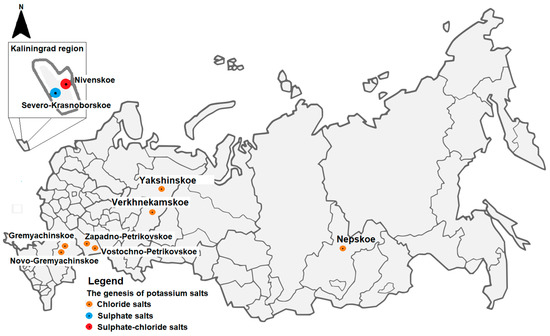
Figure 1.
Locations of potash deposits in Russia.
Potash mining activities cause severe environmental damage to the surrounding environment area [33,34]. The environmental, social, and economic problems associated with active and abandoned mines include the salinization of lands and freshwater ecosystems, ground subsidence, and the occurrence of halophyte vegetation in potash mining areas [35,36]. The impact of potash mining causes a decrease in species richness along with a decrease in the salinity gradient in freshwater ecosystems [37,38]. The direct disposal of brine into the river with extremely high chloride concentrations (up to 6 g/L) from potash mines affected aquatic fauna and caused biological degradation [39,40,41].
This paper looks into the environmental aspects of potash mining using the Verkhnekamskoe potash deposit (Russia) as an example. The mining of potash ores at the Verkhnekamskoe deposit is a striking example that shows all of the major features and problems associated with the mining of water-soluble ores [42]. Environmental assessment of the territory of closed and operating mines of the Verkhnekamskoe potash deposit revealed that freshwater salinization and soil salinization are caused mainly by solid and liquid waste generated by mining and processing, as well as industrial sites [43,44]. Despite extensive research into the environmental impact of potash production, a fairly complete and up-to-date literature review on potash deposit environmental protection is still rare. The goal of this study is to summarize and analyze the environmental impact of the potash industry based on recent studies.
The current results were classified for the purpose of developing environmental management technologies in mining based on an analysis of more than 150 recent papers published in various fields over the last 20 years, including resource management, mineral processing and waste disposal technologies, information technology, transport research, and so on.
2. Characteristics of the Verkhnekamskoe Potash Deposit
The Verkhnekamskoe potash deposit is located in the Solikamsk depression, which is one of the largest negative tectonic structures in the Pre-Ural foredeep [45]. Potash mines are currently active in the northern part of Perm Krai (Russia), in Berezniki and Solikamsk. This deposit contains sylvinite (raw material for the production of potash fertilizers), carnallite rock (for the production of synthetic carnallite for the magnesium industry), and brines (raw material for the production of soda ash, energy, and so on) [46]. Potash ore mining at the Verkhnekamskoe deposit contributed greatly to the socioeconomic development of this region and the establishment of a chemical industry center in the Solikamsk-Berezniki industrial agglomeration [47].
The Verkhnekamskoe potash deposit is one of the largest in the world. This deposit has reserves of 96.4 billion tons of carnallite rock, 113.2 billion tons of sylvinites, and 4.65 trillion tons of rock salt [48]. In 1934, the Solikamsk potash plant became the first potash producer in the Soviet Union with the commissioning of an underground potash mine, which had an annual output of 3 million tons of sylvinite and 700 thousand tons of potassium chloride (95% KCl) [49]. Following the dissolution of the Soviet Union, the Verkhnekamskoe potash deposit was mined by three companies: Uralkali, EuroChem, and Acron [50]. At the Verkhnekamskoe deposit, potash ore is mined using conventional mechanized underground mining methods at 300–465 m depths [51].
Potash ore mining at the Verkhnekamskoe Potash Deposit is distributed over 11 mining sites approved by ROSNEDRA (the Federal Subsoil Resources Management Agency). In Russia, such sites are referred to as “license sites”, which have official mining permits from the agency. Four of the mining sites are located in the central part of the deposit (Solikamsky, Novo-Solikamsky, Polovodovsky, and Borovsky), and the remaining seven mining sites are in the southern part (Bereznikovsky, Duramansky, Balakhontsevsky, Bygelsko-Troitsky, Talitsky, Palashersky, and Ust-Yayvinsky) (Figure 2). There is also a small Yuzhno-Yurchuksky mining site in the southern part of the deposit (to the northwest of the Bygelsko-Troitsky site) [48,52]. Some of the active mines are located directly beneath the cities of Berezniki and Solikamsk (populations of 148 thousand and 106 thousand, respectively) [53]. There are six producing mines in Berezniki and Solikamsk, with two more mines under construction [54].
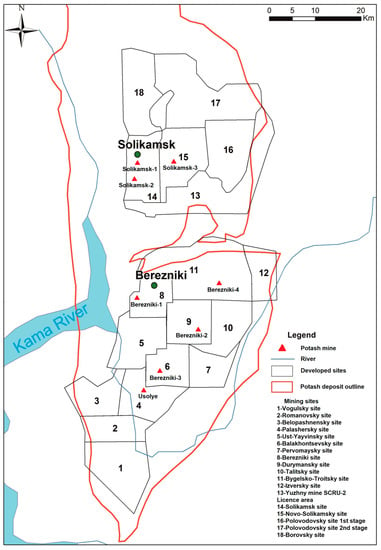
Figure 2.
Map of the Verkhnekamskoe potash deposit.
The salt stratum of the Verkhnekamskoe potash deposit is shaped like a lens, has a thickness of up to 550 m, and covers an area of approximately 8.1 thousand km2. It can be traced for 206 km in the meridional direction and up to 55 km in the latitudinal direction [55]. The salt stratum is composed of four salt layers from the Kungurian Stage (Lower Permian) [56]. The lowest underlying rock salt is composed of nearly monomineral halitites with scattered anhydrite and dolomite inclusions and rare clay and marl interlayers. Above that is a sylvinite zone with alternating layers of sylvinites and halitites, followed by a carnallite zone with intercalated carnallites and halitites. The uppermost overlying rock salt layer contains small amounts of dolomite, magnesite, anhydrite, and clay material [57]. Rocks of the Sheshma horizon (P1šš), Upper Solikamsk horizon (P1sl1), and Lower Solikamsk horizon (P1sl2) of the Permian system are formed beneath Quaternary sediments in the study area (Figure 3) [46,58].
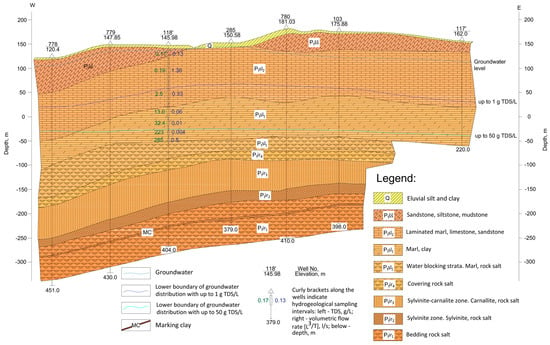
Figure 3.
Geological setting of the central part of the Verkhnekamskoe potash deposit.
The potash-bearing complex in the Verkhnekamskoe deposit features only halite, sylvin, and carnallite. The content of standard CaSO4 does not exceed 5.2; CaCl2—0.6; and MgSO4—0.2 wt % [57]. In addition to soluble sulfates and chlorides in all strata, the insoluble residue is present and distributed very unevenly both in the cross-section and in the rocks. The main minerals of insoluble residue are mainly dolomite, anhydrite, potassium feldspar, quartz, chlorite, and less frequently, illite, hematite, goethite, magnesite, gypsum, and plant detritus are present in subordinate amounts [59].
3. Potash Production Waste
The refining process at a potash mine involves several stages of separation: the ore is brought to the surface, crushed, ground, and slurried in a saturated brine of NaCl and KCl composition, and then insoluble minerals or insoluble residues are removed from the slurry using mechanical and chemical methods [60]. Potash ores contain high levels of fine water-insoluble minerals, which are referred to as “slurry” here (also, insoluble material in the waste potash ore is referred to as “slime” by various authors) [61].
The potash industry generates millions of tons of tailings (solid halite waste, clay–salt slurry, and saturated brines) [62,63]. Depending on the beneficiation method, the waste of water-soluble ores is separated into flotation and halurgic [64]. The waste generation per ton of the final product ranges from 0.99 to 4.97 tons of solid waste and 0.3 to 1.1 tons of liquid waste [65]. Potash production tailings account for approximately 75% of total production volume; the production of 1 kg of finished product generates 3 kg of waste [62,66]. Potash waste storage and disposal methods vary around the world (Table 2) and include waste disposal in potash tailings piles and tailings slurry (types of surface tailings storage facilities), underground waste storage, potash waste disposal into rivers and seas, and brine injection into deep wells [67,68,69]. Direct brine disposal into the River Werra (Germany) has resulted in chloride concentrations of up to 30 g/L [70]. To reduce anthropogenic salinization in the Llobregat River Basin, a 120-km long pipe was constructed to transport salt-saturated wastewater produced by potash mines in central Catalonia to the Mediterranean Sea [71]. Operation of such a long brine pipeline poses a risk of leaks and ruptures, resulting in salt-saturated inflows into rivers and adjacent lands.

Table 2.
Potash production waste disposal.
The chemical composition of halite waste varies depending on the beneficiation method. The dominant component in halite waste after the halurgic method is NaCl (94.30 mass fraction, %), followed by CaSO4, KCl, insoluble residue, H2Ocryst., MgCl2, Br− [64]. The chemistry of halite flotation waste of potash processing is the following: NaCl (87.78 mass fraction, %), followed by KCl, CaSO4, MgCl2, insoluble residue, H2Ocryst., Br− [80]. Fine tailings (clay–salt slurry) and excess brine from potash production are stored in tailings slurry and brine ponds, respectively [81].
From 2011 to 2021, the amount of waste generated by potash mining and processing operations at the Verkhnekamskoe deposit increased steadily from 26 million tons to 41 million tons per year, with an average of 32 million tons. More than 270 million tons of solid waste (halite waste) and more than 30 million m3 of liquid waste (clay–salt slurry) have already accumulated on the Verkhnekamskoe deposit’s territory [82]. At the same time, over the 65-year operation of the Starobinskoe deposit (Belarus), 980 million tons of halite waste and 115 million tons of clay–salt slurry have been accumulated [83]. Since the start of mining at the Tyubegatanskoe potash deposit (Uzbekistan) in 2010, more than 6 million tons of potash waste have been accumulated, with the potash plant producing 1.2 million tons of sylvinite ore per year with 27% of KCl in the ore [84].
At the Verkhnekamskoe deposit, solid and liquid wastes from the Solikamsk and Berezniki potash mines were generated during ore processing (by flotation or halurgic methods) and disposed of in tailings pile and tailings slurry [85]. Mineral composition in the liquid waste after halurgic processing are the following: anhydrite (22 wt. %), potassium feldspar (18 wt. %), sylvin and quartz (16 wt. %), dolomite (14 wt. %), halite (11 wt. %), and insignificant content of pyrite and chlorite. Flotation liquid waste is practically the same as the halurgic method [86].
Waste is stored on a specially prepared rock pile site, which is surrounded by dams and has access roads. After processing, a conveyor transports the waste to the potash tailings pile [87]. Various authors also refer to the potash tailings pile as the salt tailings pile or the salt dump [35,39]. Figure 4 shows examples of potash waste disposal facilities (potash tailings pile and tailings slurry) on the Verkhnekamskoe deposit’s territory.
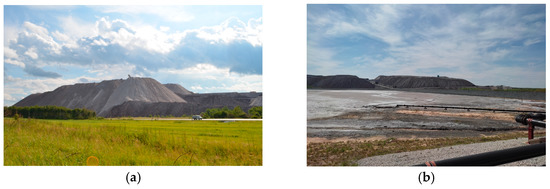
Figure 4.
Potash ore processing waste disposal facilities on the Verkhnekamskoe deposit’s territory: (a) potash tailings pile; (b) potash tailings slurry.
At the world’s largest potash production sites, the total area of land withdrawn for a salt tailings pile exceeds 5600 hectares [81]. To date, the total area of land allocated for the salt tailings pile at the Verkhnekamskoe deposit is 8.69 km2, while the tailings slurry covers 7.12 km2. In 2021, the total area of disturbed land due to the negative impact of the potash tailings pile and tailings slurry facilities was 135.7 hectares. The Potash tailings pile’s height at the Verkhnekamskoe deposit ranges from 64 to 97 m. It is up to 2200 m long and 940 m wide. The total thickness of the salt dump’s rocks is 81 m, which was discovered after drilling. At the drilling site, grayish-white, grayish-brown, coarse-grained, and low-moisture salts were found in the section. They were dumped between 1981 and 1987 (Figure 5a). The potash tailings pile is saturated with brine, starting at a depth of 41.7 m. Brines are generated when the solid phase of waste is compacted, and the liquid phase is squeezed (Figure 5b). These are typical processes for potash tailings piles.
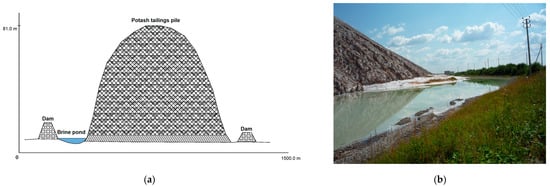
Figure 5.
(a) Potash tailings pile scheme based on drilling data; (b) photographs from the site showing the brine pond and potash tailings pile at the Verkhnekamskoe deposit.
Liquid waste is a suspension containing a solution saturated with NaCl and KCl, solid particles of the same salts, and clay minerals, which is disposed of as tailings slurry at the Berezniki and Solikamsk potash mines [88]. The tailings slurry at the Verkhnekamskoe deposit is filled with clay–salt slurry saturated with brine (101–300 g/L). In Belaruskali, tailings slurry facilities contain up to 350 g/L of brine [89,90,91]. Since the mid-1970s, approximately 8 million m3 of liquid waste has been accumulated in the tailings slurry at the Balakhontsevsky mining site of the Verkhnekamskoe deposit [92].
Long-term disposal of liquid and solid potash waste in tailings at the Verkhnekamskoe deposit using compacted clay liner became one of the most significant environmental risks associated with the migration of salt contaminants into the surrounding environment and groundwater [93]. Liquid potash waste is stored in containment facilities surrounded by dams and equipped with geosynthetic clay liners, cut-off walls, drainage zones, leachate collection systems, and/or containment wells for seepage control and collection [94]. Potash tailings have historically been mostly compacted clay lined, but increasing in their use of geotextile geomembrane liners in recent times (Figure 6). Highly efficient materials (such as high-density polyethylene geomembrane) are being used to protect groundwater from the release of saturated brine and salt-contaminated rain water from potash tailings slurry [95,96].
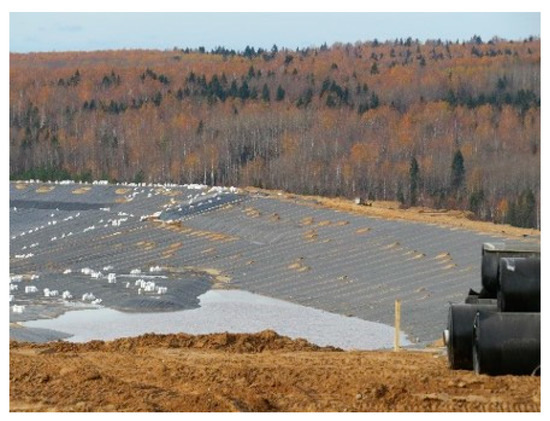
Figure 6.
Use a geomembrane in new tailing slurry facility of potash mine at the Verkhnekamskoe deposit (Balakhontsevsky mining site).
4. Environmental Consequences of Potash Mining
Potash tailings piles and tailings slurry are thought to be the primary sources of salinization of surface water and groundwater at the Verkhnekamskoe deposit (Russia) [82,83,92,97], the Starobinskoe deposit (Belarus) [27,74], the Alsatian deposit (France) [98], and the old potash deposit in Germany [99]. Potash wastes transform the chemical composition of groundwater and surface water, which results in landscape degradation and land disturbance [100]. According to preliminary estimates, the potash tailings pile contributes insignificantly to groundwater salinization when compared to tailings slurry facilities.
Saline contaminants in humid climates enter the environment much faster from potash tailings. Uncontrolled discharge of hypersaline effluents from potash waste disposal sites is an important source of groundwater salinization and surface water. Potash mining activities significant influence the chemical composition of groundwater, which is predominantly Na-Cl in composition. The hydrochemical type of groundwater and surface water changed from an HCO3-Ca type to a Cl-Na type with high salinity [82,92]. At the Verkhnekamskoe deposit, the most salt-affected alluvial plain landscapes are located in the area affected by potash mine tailings facilities [101].
4.1. Ground Subsidence
The safe and efficient use of the Verkhnekamskoe deposit subsoil is heavily reliant on mining and geological survey, as well as waterproof formation studies [102]. The main challenges of mining at the Verkhnekamskoe potash deposit are the high solubility of potash salts, the water content of the rock mass overlying the salt massif, the risk of groundwater inflow into mine workings, and subsequent flooding of the mine. Water-soluble ore mining is unique due to the need to protect mine workings from the inflow of freshwaters [103]. The practical background of potash mine operations shows that the savings on backfilling mined spaces outweigh the financial losses in the event of mine flooding. For example, the lost profit from flooding a mine with approved reserves for 20 years of mining will be around 60 billion rubles [104].
At the Verkhnekamskoe deposit, several well-documented subsidence/collapse sinkholes were caused by the flooding of potash mines in Berezniki and Solikamsk [105]. The Berezniki-3 potash mine was flooded in 1986. Later, in 2006, one of the world’s largest accidents in water-soluble ore extraction occurred at the Berezniki-1 potash mine [106,107]. The inflow of water into the underground mine at a rate of 1200 m3/h caused flooding and the closure of the mine, resulting in the destruction of underground workings [108]. The accident at the Berezniki-1 potash mine jeopardized the operation of urban and industrial buildings and structures above the mine (Figure 7a) [109]. Five sinkholes have formed since the flooding [110]. The largest sinkhole (440 × 320 m) is currently completely flooded by groundwater (Figure 7b). As a result, extensive monitoring was initiated following the mine flooding, including control over seismicity, hydro-geological parameters, and gravimetry [111]. The observations show that uneven building subsidence occurs almost continuously at a nearly constant rate, with the exception of a few buildings where the rate of deformation has increased over time. The potash company spent 16.5 billion rubles to mitigate the consequences of the Berezniki-1 potash mine accident. The mitigation measures included the construction of a new railway, a new neighborhood and its infrastructure, and citizen resettlement [112].
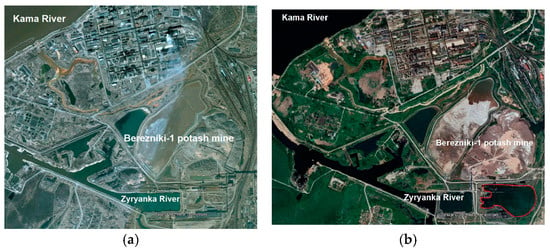
Figure 7.
The Berezniki-1 potash mine location; the background image was obtained from Google Earth: (a) May, 2006; (b) May, 2010; the red line—collapse of the Berezniki-1 potash mine.
One of the most recent collapse sinkholes (152 × 181 m) occurred in 2014, 2.3 kilometers from the Solikamsk-2 potash mine (Figure 8a), as a result of the groundwater inflow to the mine at a rate of 150 m3/h [113]. A set of measures was implemented to mitigate the consequences of the accident. A dewatering system was installed; water was pumped through 32 water interception wells (25 million m3/year); a seepage curtain was built; plugging through 34 inclined wells on the perimeter of the failure was implemented; 1.7 million m3 of clay solution was injected; and 395,000 m3 of clay material was backfilled [112]. The sinkhole has now been eliminated, and the situation continues to be monitored (Figure 8b).
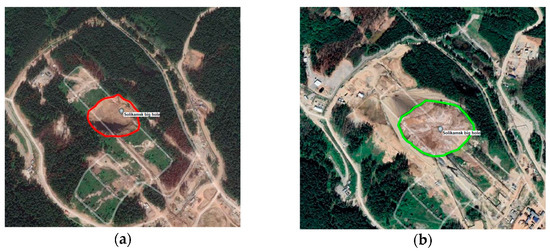
Figure 8.
Solikamsk-2 potash mine location; the background image was obtained from Google Earth: (a) August, 2016; the red line—collapse of the Solikamsk-2 potash mine; (b) August, 2022; the green line—the eliminated collapse sinkhole.
Sinkholes occurred in linearly elongated zones of large tectonic faults on the territory of the Verkhnekamskoe Deposit in 1986, 2007, 2010, 2011, and 2014 [114]. The analysis of mine engineering situations and mining and geological conditions at 11 emergency sites with sinkholes in salt mines in Canada, the United States, Spain, Russia, France, Germany, and Belarus is associated with the locations of water-conducting cracks in the mined rock mass in the area of the water-protective layer above productive salt layers. In these areas, zones with unusual geological structures were discovered in the water-protective stratum [113,115]. According to surveys conducted over the Alsatian potassic basin [116], surface subsidence decreases rapidly after mining is completed.
Subsidence control measures are being implemented at all underground potash and potassium–magnesium ore mining sites around the world [117,118]. At the Verkhnekamskoe deposit, the following integrated system of geological environmental monitoring is used: “Data of detailed and operational geological exploration”, “Land subsidence”, “Hydrogeological monitoring”, “Monitoring of mining and stowing operations and the state of workings”, “Monitoring of the physical and mechanical properties of the rock mass”, “Data on gas-dynamic phenomena”, “Seismological monitoring”, “Seismic monitoring”, and “Hydrogeodeformational monitoring” [119,120].
4.2. The Impact of Potash Mines on the Chemical Composition of the Atmosphere
The chemical composition of atmospheric precipitation (snowmelt) in potash mining areas around the world has changed over the last century [121,122,123]. In potash mining areas, the main water-soluble ions in the atmosphere are associated with NaCl in the composition of the atmospheric dust coming from the salt mine shaft to the surface [124]. Salt dust easily migrates from mine workings through air flow, aided by potash salt mine dedusting solutions and mining equipment [125]. The potash mine aerosol in underground chambers contains sodium chloride, which constitutes more than 80% of particulate matter. It is highly soluble in water, mainly in a dissociated state [126].
The impact of the potash industry on the chemical composition of atmospheric air can be assessed using snow measurements, considering the average duration of snow cover in Perm Krai (174 days; 124 to 203 days if the snow is scattered) and its high sorption capacity [127]. For more than ten years, the authors have been conducting such studies in the area affected by potash mining. The snow sampling procedure is shown in Figure 9.
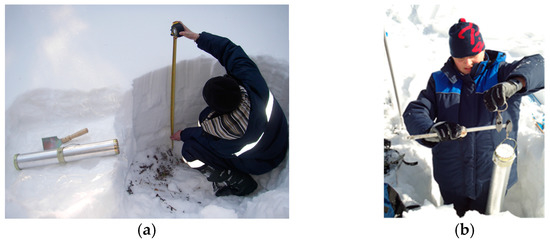
Figure 9.
Snow sampling procedure: (a) measuring the height of the snow cover; (b) weighing the snow.
In the area affected by atmospheric emissions from the Verkhnekamskoe potash deposit plants, the chemical composition of the snow reflects the input of potash extraction and processing ingredients—Cl−, Na+, and K+ [128]. High values of Cl−/Na+, Cl−/SO42−, and Na+/K+ ratios in snowmelt indicate increased contributions to air emissions from potash plants [129]. In comparison to the average characteristics of snowmelt water in the Berezniki urban district, the TDS level is high in the area from the SPZ (sanitary protection zone) border to the residential area, with its maximum level in the transport zone. It is considerably lower in the mining area and even lower in the recreational area (Table 3). Snowmelt water in potash mining areas is acidic, with an average pH of 5.27. In contrast to other parts of the city, the priority ions in snowmelt water within the potash mining area are Na+, K+, and Cl−.

Table 3.
Average values of the major ions in snowmelt in the Berezniki urban district.
The hydrochemical type of snowmelt on the territory of potash plants ranges from Cl−-K+-Na+ to НСО3−-NO3−-SO42−. Snowmelt at the SPZ border is dominated by the HCO3−-Cl−-K+ set, whereas snowmelt in other areas of the Berezniki urban district is dominated by HCO3−-Ca2+ associations. The identified anomalies in the potash mining area are local in nature and do not extend beyond the enterprises’ SPZ.
4.3. The Impact of Potash Waste on the Chemical Composition of Surface Water
At the Verkhnekamskoe deposit, salinization of the freshwater ecosystem caused by the effect of potash tailings is currently widespread in local rivers. Mainly, potash mine tailings cause surface water salinization in the Lyonva River on the Balakhontsevsky mining site. In natural conditions, the rivers at the Verkhnekamskoe deposit have a calcium-hydrocarbonate chemical composition, but brine-impacted waters from several potash mine tailings changed the river water’s composition into a sodium chloride composition in 2018–2019 [92] and 2020.
Table 4 shows the high TDS levels and water-soluble ion content of the Lyonva River. The presence of potash mines and tailings facilities in the upper and middle reaches of the Lyonva River (Figure 10) greatly affects its chemical composition. In the upstream (sampling point 1) of the Lyonva River, 12 g/L of TDS were found. After the brine inflow from the potash tailings slurry and a series of salt spring discharges, 14 g/L of TDS and 12 g/L of Cl− were found in the midstream (sampling point 2). High contents of soluble salts and TDS persist up to the area near the Lyonva River mouth (sampling point 3): 8.3 g/L (Cl−), 2.5 g/L (Na+), 1.8 g/L (K+), and 18 g/L (TDS).

Table 4.
Chemical compositions of the Lyonva River and the background river.
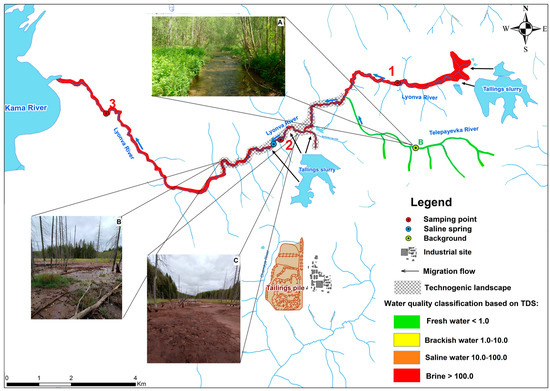
Figure 10.
Location of sampling point in the area affected by the potash tailings slurry and tailings pile in the Lyonva River (Balakhontsevsky mining site).
The total length of the Lyonva River is 21 km, of which approximately 17 km is subject to salinization (Cl and Na ions predominate). TDS values in the Lyonva River exceed those of the background sampling point in the Telepayevka River by 30–45 times.
Freshwater salinization on the territory of the Verkhnekamskoe Deposit is accompanied by a decrease in total biomass, a decrease in species diversity in aquatic ecosystems with a predominance of halophilic rotifers and copepods, and a disturbance in the fish population [130]. The values of algocenoses’ structural indicators (biomass and density) are lower in rivers with high salinity [131]. Thus, long-term discharge of Cl—Na+ effluents from waste disposal sites alters the chemical composition of groundwater and surface water and causes soil salinization in river floodplains affected by potash mining [82,83,92].
4.4. The Impact of Potash Waste on the Chemical Composition of Groundwater
The impact of surface potash waste storage is the most important factor influencing groundwater composition [132,133]. The main environmental problem for the potash industry is vertical or lateral brine migration from the potash tailings to groundwater and soils. The chemical composition of groundwater in the aquiferous Upper Solikamsk horizon (P1sl2) was studied as an example of such an influence. It is the primary fresh groundwater collector, and it can be found in the Upper Permian sediments of the Verkhnekamskoe deposit’s upper profile (Figure 3).
The groundwater of the Upper Permian Solikamsk sediments above the Kama River valley level (105–110 m) is mainly fresh with a hydrocarbonic magnesium–calcium and calcium–sodium composition (up to 0.6 g/L). Below it are saline waters of mainly chloride–sulfate, sulfate–chloride, and rarely sulfate composition with 1.6–14.0 g/L of TDS, which are replaced by chloride-rich brines with depth [46].
The study area is located in the northern part of the Novo-Solikamsky mining site of the Verkhnekamskoe potash deposit (Figure 11). The highest elevations (220–251 m) on the Usolka River’s left bank are in the watershed between the Usolka and Selyanka Rivers, where potash mining waste disposal facilities are located. The lowest elevations (110–120 m) are found in the Usolka River, where springs S1–S4 are located.
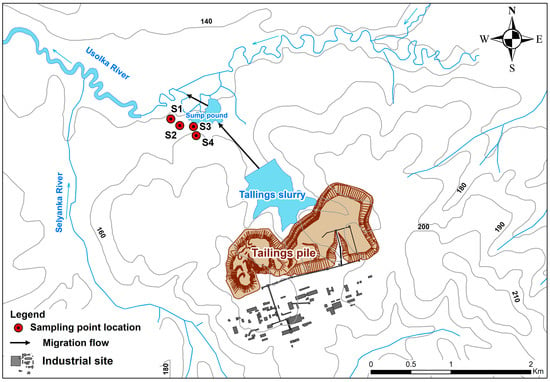
Figure 11.
Location of springs in the area affected by the potash tailings slurry and tailings pile of the Novo-Solikamsky mining site.
A group of springs discharged on the southwestern shore of a technogenic lake located 800 m northwest of the tailings slurry was studied to characterize technogenic changes in the chemical composition of spring runoff. From 1998 to 2016, springs were sampled four times a year during major phases of the hydrological cycle (winter low flow, spring flood, summer–autumn low flow, and autumn floods). A total of 59–60 samples were examined each spring. Table 5 shows the findings of the studies. The ionic composition was characterized based on the OST 41-05-263-86 ionic composition formula.

Table 5.
Chemical composition summary of the Upper Solikamsk subformation springs in the area affected by potash surface tailings storage facilities, based on monitoring data from 1998 to 2016.
According to spring sampling, groundwater in the Upper Solikamsk horizon has a calcium–sodium chloride composition. The waters are neutral according to the pH value, and the concentration of bromides increases proportionally to the increase in mineralization. There is a consistent seasonal increase in dissolved substances during low flow periods. There are no signs of natural salinization of groundwater (seen as an increase in the concentration of sulfate ions).
The most saline spring (S1) has Cl−-Na+ hydrochemical facies, while the less-saline springs (S2–S4) have an Cl−-Na+-Са2+ facies. The heterogeneous filtration characteristics of the aquifer can cause differences in the chemical composition of groundwater in different springs. As a result, sodium chloride water from a tailings slurry can reach the discharge point faster (sampling point S1) or slower. The filtration rate determines the degree of dilution of the brine with fresh groundwater and the intensity of ion exchange reactions that enrich calcium ions.
The processes of chloride water formation with high concentrations of calcium and magnesium cations within mining areas of the Verkhnekamskoe deposit were studied in a laboratory using brines and soil samples. The findings of the “brine-rock” system interaction study confirmed the occurrence of ion-exchange processes between the solid phase of rocks and the liquid phase of the brine. Calcium and magnesium ions enter saturated brines, which, after further dilution, form groundwater with atypical magnesium–calcium and calcium–sodium chloride compositions. Exchangeable sodium and potassium are present in soil [134,135].
The results of springs sampling (the discharge of which occurs near existing potash plants and surface tailings storage facilities) showed a considerable change in groundwater chemical composition. These springs are characterized by a significant increase in the levels of salinity and general hardness, and the water facies have evolved from HCO3-Ca type to Na-Cl type. Groundwater salinization caused by potash tailings has shown similar results in Germany and France [98,136].
4.5. The Impact of Potash Waste on the Chemical Composition of Soils
Potash tailings caused the salinization of floodplain soils of the Lyonva River and Chyornaya River (Balakhontsevsky mining site of the Verkhnekamskoe deposit) (Figure 12 and Figure 13). Soddy-podzolic soils typical of the taiga zone are most common on the territory of the Verkhnekamskoe potash deposit. This type of soil forms in coniferous forests and has low agrochemical properties, is acidic, and has a humus content of 2–6% on average. Soddy-podzolic soils on sandy and sandy loamy rocks are structureless. Sandy loamy soils with a large silt fraction may have a fragile structure: layered in the podzolic horizon and a fragile cloddy in the texture-differentiated (illuvial) horizon.
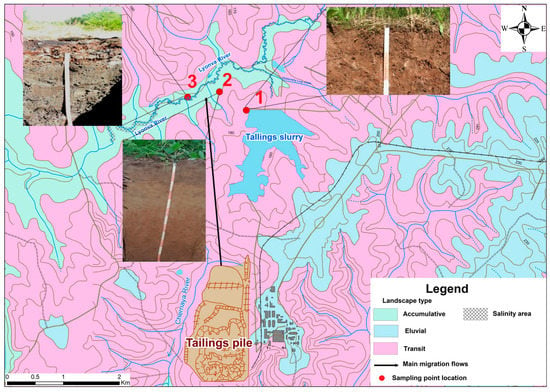
Figure 12.
Locations of soil sampling points in the area affected by the potash tailings slurry and tailings pile of the Balakhontsevsky mining site.
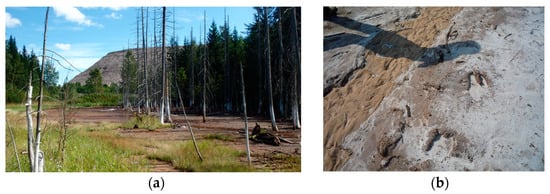
Figure 13.
(a) Salinization processes in the Chyornaya River floodplain sections in areas affected by the potash tailings pile; (b) moose traces in the salinity zone.
Three soil samples were collected in the area from potash tailings slurry, downhill, and towards the Lyonva River floodplain. The soils were sampled at three different distances from the potash tailings slurry on three different types of geochemical landscapes: sampling point 1–140 m from the tailings slurry (eluvial landscape); sampling point 2–770 m from the tailings slurry (transit landscape); and sampling point 3–1250 m from the tailings slurry (alluvial landscape in the Lyonva River floodplain). The elevation of the relief between the potash tailings slurry and the Lyonva River floodplain is 180 and 130 m.
Sampling point 1 has no distinct soil horizons and no underlayer. It has a large number of crushed stone inclusions, a loose structure on the surface, and a more solid structure at depth. The granulometric composition is clayey and heavy loamy. The WRB (2015) [137] classifies this soil as a technogenic surface formation (Technosols Loamic). Low SAR, Cl−, Na+, and SO42− values in the soil indicate no salinity (Table 6).

Table 6.
Content of SAR, Cl−, Na+, and SO42− in soils affected by the potash tailings slurry.
Sampling point 2 (transit landscape) is located in a mixed forest. This soil is classified by the WRB (2015) as a typical soddy-podzolic sandy loam soil and Podzols (Figure 12) [131]. This type of soil has no structure and an extremely low water-holding capacity. The humus content ranges from 1.5 to 6% in the humus horizon and 0.2 to 0.5% in the illuvial horizon. Sampling point 2 is located on a slope; therefore, the SAR, Cl−, Na+, and SO42− values indicate no salinity (Table 6).
The soil profile (sampling point 3) in the Lyonva River floodplain was chemically and physically altered as a result of strong salinization processes. Soil salinization centers are most prominent in superaqueous (accumulative) landscape types, where saline groundwater in the Lyonva River valley discharges areally. The groundwater has a Cl-Na composition, with chloride concentrations ranging from 6.5 to 26 g/L, and sodium concentrations ranging from 2.5 to 11.0 g/L [83]. This saline groundwater was formed as a result of brine filtration through the dam of the tailings slurry. The salinization process transformed the alluvial soil into a secondary gleyic Chloridic Gleyic Fluvic Solonchak (Hypersalic, Loamic, Technic), according to the WRB Classification (2015) [137] (Figure 12, Point 3) [92]. In sampling point 3, a salinity gradient was detected. Elevated values of SAR, Cl−, Na+, and SO42− are presented in Table 3 and indicate a high soil salinity at this sampling point.
Soil salinization has also been found in the floodplains of the Chyornaya River, the Volim River (Balakhontsevsky mining site), the Popovka River, the Usolka River (Solikamsk mining site), and the Bygel River (Bygelsko-Troitsky mining site) [83,133]. According to [92,138], the potash waste transformed typical alluvial humic gley clay soils in the superaquatic (accumulative) landscapes of the Lyonva River, Chyornaya River, and Bygel River into various types of solonchak. Salinization of alluvial soil (in local river floodplains) is mainly caused by the brine inflow from potash tailings (lateral movement of released brine into freshwater aquifers).
Soil salinization is associated with brine filtration from the potash tailings pile in the Chyornaya River floodplains (alluvial soil types) (Figure 13a). The topsoil (up to 0.1 m) of these alluvial soils contain cations and anions in the following order (by concentration): CО3− > Cl− > SO42−. The predominant cations and anions HCO3−, Na+, and Cl− reach the following values: 0.52 g/kg, 0.15 g/kg, and 0.12 g/kg, respectively. The subsoil (up to 0.4 m) has the highest salt concentration with the following order (by concentration): Cl− > HCO3− > SO42−. Major ion concentrations (Cl−, Na+, and K+) are 0.46 g/kg, 0.22 g/kg, and 0.14 g/kg, respectively. Moose traces are frequently found in saline areas (Figure 13b). High salt concentrations in such areas compensate for a lack of salt in horned males as well as pregnant and lactating females.
The highest salt concentrations were found in alluvial soils in superaqueous (accumulative) landscapes and river floodplains. Saline areas form at the base of slopes where swampy areas exist. The stagnant hydrodynamic regime in these areas enhances salt concentrations and creates an environmentally hazardous situation. Transformed alluvial soils of the Lyonva River and the Chyornaya River have a salinity gradient as a result of the long-term influence of highly saturated brine from potash tailings mine on the territory of the Balakhontsevsky mining site.
Salinization of the fertile soil layer was found near the Soligorsk mining district (Belarus) [139]. High contents of soluble salts and trace elements were found in soils affected by the Soligorsk potash plant [140]. In comparison to the background values, an excess amount of K+, Na+, and Cl− (7–10 times) was found at the SPZ border. At a distance of 3 km from the plant, the excess is 3–5 times greater, and at a distance of 10 km, the excess is 1.5 times greater. Salinization in the floodplain soil of the Werra River (Germany) had a strong depressive effect on the microbial biomass and shifted the microbial community structure [141]. The salinization process in the Werra River floodplain is caused by saline liquid residues injected into the underground geological formations.
4.6. The Impact of Potash Waste on the Vegetation
Based on the monitoring data, two vegetation groups can be distinguished in areas of stable and unstable salinization near the potash tailings pile of the Solikamsk-1 and Solikamsk-2 potash mines [142]. In the stable salinization zone (1–5 m from the potash tailings pile), vegetation communities have low projective cover (no more than 10–30%) and low species diversity. Typical species for this area are blue lettuce (Lactuca tatarica), oak-leaved goosefoot (Chenopodium glaucum), weeping alkali grass (Puccinellia distans), bush grass (Calamagrostis epigeus), dandelion (Taraxacum spp.), and bull’s-foot (Tussilago farfara). Grasses were also found in this area (Agropyron repens, Bromus inermis, and Poa pratensis).
The predominant part of the Solikamsk-1 and Solikamsk-2 potash mines of potash tailings piles (unstable salinization zone at 5–90 m from the tailings piles) were occupied by ruderal communities with a predominance of perennial grasses (Calamagrostis epigeios, Bromus inermis, Agropyron repens, and Phleum pratense) and herbaceous elements (Lathyrus pratensis, Leucanthemum vulgare, Melilotus albus, Trifolium repens, etc.); projective cover is 100% (Figure 14). This plant grouping represents the pre-meadow stage of regenerative succession.
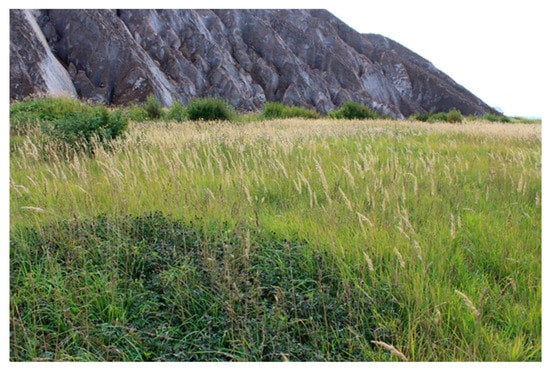
Figure 14.
Grass and reedgrass meadow near the potash tailings pile of the Solikamsk-2 mine.
The vegetation near the potash tailings pile is represented mainly by meadow plant communities (the Verkhnekamskoe deposit) with ruderal species, but invasive halotolerant plant species are found in saline areas.
In soil salinization centers (floodplain of the Lyonva River), meadow plant communities are found with a small portion of halophilic grasses (Calamagrostis epigejos, Festuca rubra, Typha latifolia L. (bulrush)) and halophytes (Atriplex prostrata, Puccinellia hauptiana, and Spercularia salina) [143].
In addition, among the salt-tolerant flora, we found the weeping alkaligrass Puccinellia distans (Jacq.) Parl., blue lettuce Lactuca tatarica (L.) C.A. Mey., oak-leaved goosefoot Chenopodium glaucum L., spear saltbush Atriplex patula L. Among the unique flora, arrow-grass Triglochin maritimum L. was found (Figure 15). Typical habitats of this species are moistened saline soils on the northern sea coasts and solonchaks [143,144]. Typical taiga plant species die as a result of intense salt stress in terrestrial landscapes, and the liberated ecotopes are replaced by salt-resistant plant communities [83,93,144].
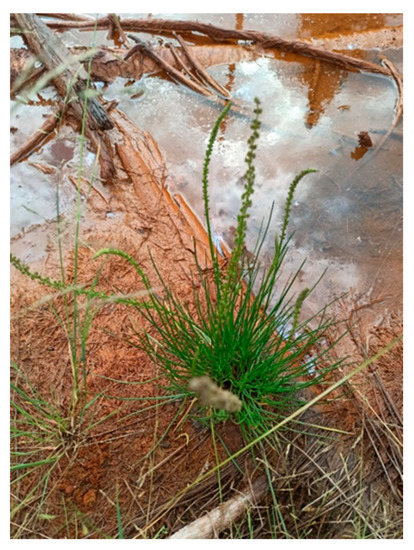
Figure 15.
Arrow-grass (Triglochin maritimum L.) on the floodplain soils of the Lyonva River.
4.7. Radiation Situation at the Verkhnekamskoe Potash Deposit
Currently, gamma spectrometric measurements of the natural radionuclides activity in various environmental objects are widely used to assess the ecological state of the territory. Similar studies have been conducted for soils, bottom sediments [145,146], and various wastes [147,148], and are frequently used in the coal industry [149,150].
The research area includes the Solikamsky, Novo-Solikamsky, and Polovodovsky mining sites. A total of 75 soil samples (from 0–0.4 m layer) and 6 bottom sediment samples were taken from representative sites around the potash plant. Soil samples and bottom sediment samples were air-dried at room temperature under laboratory conditions. The entire organic portion of the dried samples was removed, and the samples were prepared for the study of the specific activity of natural radionuclides (40K, 226Ra, 232Th). An MKS-01A MULTIRAD device (Russia) was used for gamma spectrometry. The Progress software package was used to process gamma spectra. The specific activity error was approximately ±(20–30)% of the measured value.
In soils, the activity values of 226Ra, 232Th, and 40K ranged from 2.67–36.1 Bq/kg, 0.55–28.1 Bq/kg, and 19.9–562.0 Bq/kg, respectively (Table 5). Bottom sediments (six samples of the finely dispersed fraction) were collected from streams near operating potash enterprises. In bottom sediments, the activity values of 226Ra, 232Th, and 40K ranged from 2.39 to 12.6 Bq/kg, from 6.08 to 16.8 Bq/kg, and from 131.2 to 314.0 Bq/kg, respectively (Table 7).

Table 7.
Generalized data on the activity concentration of natural radionuclides in soils and bottom sediments within the territory of the Verkhnekamskoe deposit and other parts of the world, Bq/kg.
Potash ore mining releases 40K into the environment. A radiation study of the core sample from an exploration well in the study area (Table 8) shows that productive potash formations have high 40K activity due to their mineral composition [151]. The highest values for the studied deposit are typical for speckled sylvinites (up to 4967 Bq/kg), which is considerably higher than the activity of 40K for sedimentary rocks and the continental crust. At the same time, all tested rock samples of milled ore, and halite waste do not exceed the permissible value of 740 Bq/kg in terms of the rated specific effective activity [151].

Table 8.
Activity concentrations of 226Ra, 232Th, and 40K in rocks from an exploration well and milled ore.
A walking gamma survey was conducted on the territory of the Verkhnekamskoe deposit to estimate the ambient dose equivalent of continuous gamma radiation using the MKS/SRP-08A search dosimeter-radiometer (Russia). The measured values during the gamma survey ranged from 0.06 to 0.25 µSv/h, which is less than the established ambient dose equivalent rate of continuous gamma radiation for residential and industrial areas (0.3 and 0.6 µSv/h, respectively).
Despite the high activity of 40K in extracted potash ores, the value of this indicator for most of the studied soil and bottom sediment samples from the Solikamsky, Novo-Solikamsky, and Polovodovsky mining sites does not exceed the permissible limits, nor does it exceed the world average.
5. Environmental Impact Minimization
Hydraulic backfilling of solid and liquid potash wastes into mined-out underground openings at the Verkhnekamskoe deposit recommended by the Russian state standard (GOST R 55100-2012) [155] in the field of resource-saving for mining waste management, taking into account the availability of technology [156]. Data from Uralkali show that backfilling is the most common method of utilizing large-tonnage wastes from the potash industry, with a directional growth trend in recent years (Table 9). The information provided is attributed to the efficiency of ensuring the environmental safety of potash mining, which involves a combination of protecting underground mines from flooding, reducing the earth’s surface subsidence, and reducing the areas of salt dumps and slurry storage facilities, the expansion of which requires considerable financial investments. According to official data, Uralkali’s total expenses for hydraulic backfill operations from 2011 to 2017 amounted to 12.7 billion rubles. Existing hardening backfill technologies [157] aim to increase salt mining by reducing inter-chamber pillars.

Table 9.
Waste generation and use by Uralkali according to the reports “On the state and protection of the environment in Perm Krai” [158].
The implementation of the integrated use of raw materials in the production of potash fertilizers involved brine preparation for the needs of soda ash production, technical salt production, and the shipment of unrefined technical salt. Official reports [158] do not currently include information on the extent of these activities.
Potash plants in Berezniki and Solikamsk are using industrial water supply systems to reduce the environmental impact of potash mining. They are also reusing treated and disinfected domestic effluent, treated rainwater, and industrial effluent. These measures allow for major reductions in both the volume of wastewater discharged into water bodies and the intake of natural water into the production cycle. Despite the abovementioned measures, Uralkali is among the enterprises that contribute to water pollution in Perm Krai (Table 10). Uralkali produces 12–20% of the total mass of pollutants wastewater discharging into rivers and Kama reservoirs in Perm Krai.

Table 10.
Water consumption and disposal in Perm Krai, according to the report “On the state and protection of the environment in Perm Krai” [158].
The primary sources of fine particulate matter (NaCl and KCl) emissions from potash fertilizer production are the dry crushing of sylvinite ore, drying of fine-grained concentrate, and granulation of potassium chloride. In order to capture these emissions, modern exhaust gas purification systems are installed at all sources of gas and dust emissions.
The results of data monitoring show that there are no exceedances of the maximum allowable concentrations (0.3 mg/m3 for KCl and 0.5 mg/m3 for NaCl). The air emissions from potash plants are assessed by studying the specific activity of 40K in soils and bottom sediments around near potash mining areas [145,146].
6. Abandoned Potash Mine Ecological Resource Development
When looking at the history of potash mining, three operational stages can be identified: operation (mining), abandonment, flooding, or flooding of abandoned salt mines [159]. The final stage of potash mining is the closure of potash mines, which is usually performed by a “wet” method. As a result of an emergency situation and the freshwater inflow into the underground mine, the mine is flooded and then abandoned [160]. There are currently approximately 100 flooded mines in various countries, including Vanscoy and Patience Lake (Canada), Holle (Congo), Von der Heydt, Agathe, and Manteuffel (Germany), and the Berezniki-1 and Berezniki-3 potash mines (Russia), which were never restored and remain flooded [161]. In general, the closure of potash mines and chemical plants has greatly reduced chloride pollution in these areas [162].
The extraction of rare metals and minerals from waste, as well as the use of mines for hazardous waste disposal, are the directions for implementing circular economy principles in potash waste and underground mine management [163]. Thus, underground disposal of hazardous waste has been practiced in Germany for the past 20 years [164,165]. The Morsleben and Asse repositories are notable examples of radioactive waste disposal in the Zechstein beds [166]. European legislation defines hazardous waste storage in salt mines as the use of a host rock environment as a geological barrier that prevents hazardous substances from migrating [167].
Salts and brines from evaporite deposits are potential sources of not only basic elements such as sodium (Na), calcium (Ca), magnesium (Mg), potassium (K), chlorine (Cl), bromine (Br), and iodine (I), but also a large number of rare trace elements such as lithium (Li), strontium (Sr), rubidium (Rb), boron (B), cesium (Cs), and orgallium (Ga), which are considered in the world as strategic and critical ore materials [168,169]. Sc was found in considerable amounts in the clay–salt slurry in Solikamsk-1 potash mine [170], which is in demand by the nuclear power, space, and aviation industries. The element is associated with calcium minerals (gypsum, dolomite, and apatite) in insoluble salt sediment. In addition, after processing potassium–magnesium ores, a complex of noble metals (Au, Ag, Pt, and Pd) was found in the waste at the Verkhnekamskoe deposit, where it was discovered that the content of noble metals in the liquid waste corresponds to industrially significant ones [171].
Lithium demand has greatly increased over the last decade as the element has become a critical component in the manufacturing of a variety of new products, particularly batteries for electronic devices and electric vehicles. Furthermore, an increase in demand for this element has been observed in the glass and ceramic industries, owing to lower energy costs and easier product processing when using Li [172]. At the same time, the structure of the natural sources of its production has greatly changed over the last 50 years, and today, up to 70% of the world’s extraction of this element is carried out through the exploitation of brines from endorheic salt lakes [173]. Because lithium is geochemically associated with magnesium and potassium, it is promising to investigate the content of this metal in salt waste and clay–salt slurry from potash deposits.
Brines are prepared for the needs of soda ash production, technical salt production, and shipment of unrefined technical salt as part of the implementation of approaches for the integrated use of raw materials in the production of potash fertilizers at the Verkhnekamskoe deposit. Components from liquid waste can be used as cement mortar and concrete additives [174].
The health improvement of the population is an important and already implemented direction of using the underground mine of such enterprises. The microclimate underground salt chambers are actively used as a health resort for respiratory disease treatment [175]. The climatotherapy method (subterraneotherapy) is used in a few places around the world, including the Salt Mines in Wieliczka and Bochnia (Poland), in Turda (Romania), in Zlote Hory (Czech Republic), and Berchtesgaden (Germany) [126,176].
7. Conclusions
In many parts of the world, potash ore mining is the backbone of the economy and a source of national wealth. The use of fertilizers to increase agricultural productivity is a global standard for ensuring the population’s life and health. Enterprises producing potash fertilizers contribute to one of the global sustainable mining goals by ensuring food security, improving nutrition, and promoting sustainable agricultural development as the most important measure in the fight against hunger. At the same time, the production of a significant quantity of fertilizers implies an increase in the volume of mining and processing potash ores, as well as an increase in the volume of liquid and solid waste, which is primarily disposed of on the earth’s surface in potash tailings piles and tailings slurry. Responsible and detailed forecasting of the environmental consequences of potash ore mining is a priority in the mining of these water-soluble potash salt deposits. The direction toward reducing environmental impact is also environmental management, which uses elements of a circular economy and is supported by strict environmental regulations.
Author Contributions
Conceptualization, E.U. and E.M.; methodology, E.M. and E.K.; software, R.P.; validation, E.M., E.K. and P.B.; formal analysis, E.U. and A.P.; investigation, E.U., A.P. and R.P.; resources, E.M. and E.K.; data curation, P.B.; writing—original draft preparation, E.U. and A.P.; writing—review and editing, E.U., A.P. and E.M.; visualization, R.P. and E.U.; supervision, E.M.; project administration, P.B.; funding acquisition, P.B. and E.K. All authors have read and agreed to the published version of the manuscript.
Funding
This research was funded by Presidential Grant No. МК-4377.2022.1.5 and the Ministry of Science and Higher Education of the Russian Federation project FSNF-2020-0021.
Data Availability Statement
Data can be made available upon request.
Acknowledgments
The authors would like to thank the Nanomineralogy Sector of the Center for Collective Perm State University for conducting laboratory analysis.
Conflicts of Interest
The authors declare no conflict of interest.
References
- Sharma, P.P.; Yadav, V.; Rajput, A.; Kulshrestha, V. Synthesis of Chloride-Free Potash Fertilized by Ionic Metathesis Using Four-Compartment Electrodialysis Salt Engineering. ACS Omega 2018, 3, 6895–6902. [Google Scholar] [CrossRef] [PubMed]
- Türk, T.; Üçerler, Z.; Burat, F.; Bulut, G.; Kangal, M.O. Extraction of Potassium from Feldspar by Roasting with CaCl2 Obtained from the Acidic Leaching of Wollastonite-Calcite Ore. Minerals 2021, 11, 1369. [Google Scholar] [CrossRef]
- Ali, M.M.E.; Petropoulos, S.A.; Selim, D.A.F.H.; Elbagory, M.; Othman, M.M.; Omara, A.E.-D.; Mohamed, M.H. Plant Growth, Yield and Quality of Potato Crop in Relation to Potassium Fertilization. Agronomy 2021, 11, 675. [Google Scholar] [CrossRef]
- Chen, W.; Geng, Y.; Hong, J.; Yang, D.; Ma, X. Life cycle assessment of potash fertilizer production in China. Resour. Conserv. Recycl. 2018, 138, 238–245. [Google Scholar] [CrossRef]
- U.S. Geological Survey. Mineral Commodity Summaries 2021; U.S. Geological Survey: Reston, VA, USA, 2021. [CrossRef]
- Wang, X.; Miller, J.D.; Cheng, F.; Cheng, H. Potash flotation practice for carnallite resources in the Qinghai Province, PRC. Miner. Eng. 2014, 66–68, 33–39. [Google Scholar] [CrossRef]
- U.S. Geological Survey. Mineral Commodity Summaries 2022; U.S. Geological Survey: Reston, VA, USA, 2022. [CrossRef]
- Ciceri, D.; Manning, D.; Allanore, A. Historical and Technical Developments of Potassium Resources. Sci. Total Environ. 2015, 502, 590–601. [Google Scholar] [CrossRef]
- Andreiko, S.; Baryakh, A.; Lobanov, S.; Fedoseev, A. Geo mechanical Estimation of Danger of Gas-Dynamic Failure During Potash Deposits Mining. Procedia Eng. 2017, 191, 954–961. [Google Scholar] [CrossRef]
- Mamaev, Y.A.; Vlasov, A.N.; Mnushkin, M.G.; Stolnikova, P.V. Changing structure of deformation area of undermined rock layer upon one-layer multichamber mining of salt deposit. Geoecol. Eng. Geol. Hydrogeol. Geocryol. 2021, 12, 32–38. (In Russian) [Google Scholar] [CrossRef]
- Sokol, D.G.; Le Quang Phuc; Than Van Duy. Safety improvement in recycle development headings in potash mines: Current problems and prospects. MIAB. Mining Inf. Anal. Bull. 2020, 12, 33–43. (In Russian) [Google Scholar] [CrossRef]
- Broughton, P.L. Economic geology of southern Saskatchewan potash mines. Ore Geol. Rev. 2019, 113, 103117. [Google Scholar] [CrossRef]
- Pichat, A. Stratigraphy, Paleogeography and Depositional Setting of the K–Mg Salts in the Zechstein Group of Netherlands—Implications for the Development of Salt Caverns. Minerals 2022, 12, 486. [Google Scholar] [CrossRef]
- Lavrenko, S.A.; Shishlyannikov, D.I. Performance Evaluation of Heading-and-Winning Machines in the Conditions of Potash Mines. Appl. Sci. 2021, 11, 3444. [Google Scholar] [CrossRef]
- Seifi, C.; Schulze, M.; Zimmermann, J. Solution procedures for block selection and sequencing in flat-bedded potash underground mines. OR Spectrum 2021, 43, 409–440. [Google Scholar] [CrossRef]
- Lanzerstorfer, C. Potential of industrial de-dusting residues as a source of potassium for fertilizer production—A mini review. Resour. Conserv. Recycl. 2019, 143, 68–76. [Google Scholar] [CrossRef]
- Santos, S.; Casagrande, P.; Nader, P.; Oliveira, M.; Henriques, A. Technical feasibility study of the exploitation of seabed potassium salts by solution mining. J. Mater. Res. Technol. 2022, 16, 433–441. [Google Scholar] [CrossRef]
- Zelek, S.M.; Stadnicka, K.M.; Toboła, T.; Natkaniec-Nowak, L. Lattice deformation of blue halite from Zechstein evaporite basin: Kłodawa Salt Mine, Central Poland. Miner. Petrol. 2014, 108, 619–631. [Google Scholar] [CrossRef]
- Liskova, M.Y. Geoecology with modern construction enterprises on extraction and enrichment of potassium and magnesium salts. News Tula State Univ. Sci. Earth 2016, 4, 39–49. (In Russian) [Google Scholar]
- Royer, J.J.; Litaudon, J.; Filippov, L.O.; Lyubimova, T.; Maximovich, N. 3D geostatistical modelling for identifying sinkhole disaster potential zones around the Verkhnekamskoye potash deposit (Russia). J. Phys. Conf. Ser. 2017, 879, 12018. [Google Scholar] [CrossRef]
- Prakash, S.; Verma, J.P. Global perspective of potash for fertilizer production. In Potassium Solubilizing Microorganisms for Sustainable Agriculture; Meena, V.S., Maurya, B.R., Verma, J.P., Meena, R.S., Eds.; Springer: New Delhi, India, 2016; pp. 327–331. [Google Scholar] [CrossRef]
- Kemp, S.J.; Smith, F.W.; Wagner, D.; Mounteney, I.; Bell, C.P.; Milne, C.J.; Gowing, C.J.B.; Pottas, T.L. An improved approach to characterize potash-bearing evaporite deposits, evidenced in North Yorkshire, United Kingdom. Econ. Geol. 2016, 111, 719–742. [Google Scholar] [CrossRef]
- Shen, L.; Siritongkham, N. The characteristics, formation and exploration progress of the potash deposits on the Khorat Plateau, Thailand and Laos, Southeast Asia. China Geol. 2020, 3, 67–82. [Google Scholar] [CrossRef]
- Orris, G.J.; Cocker, M.D.; Dunlap, P.; Wynn, J.; Spanski, G.T.; Briggs, D.A.; Gass, L. A Global Overview of Evaporate-Related Potash Resources, Including Spatial Data-Bases of Deposits, Occurrences, and Permissive Tracts; Scientific Investigations Report, 2010-5090-S; U.S. Geological Survey: Reston, VA, USA, 2014. [CrossRef]
- Shen, L.; Wang, L.; Liu, C. Age of the Mengyejing potash deposit in the Simao Basin, southwest China: Constraints from detrital zircon U-Pb ages. Ore Geol. Rev. 2022, 149, 105097. [Google Scholar] [CrossRef]
- Titkov, S.N. Role of VNII Galurgy in developing of domestic mining-and-chemical industry. Gorn. Zhurnal 2016, 4, 5–10. (In Russian) [Google Scholar] [CrossRef]
- Golovatyy, I.I. JSC “Belaruskali”—The world’s largest producer of potash fertilizers. Gornyi Zhurnal 2018, 8, 4–9. (In Russian) [Google Scholar]
- Zemskov, A.N.; Maksimovich, N.G.; Meshcheryakova, O.Y. Modern trends in the development of the potash industry in the world. News Tula State Univ. Sci. Earth 2022, 3, 369–382. (In Russian) [Google Scholar]
- Maksimovich, N.G.; Meshcheryakova, O.Y. Karst Features of the Garlyk Potash Deposit Area, Turkmenistan. Bull. Perm Univ. Geol. 2016, 2, 64–71. (In Russian) [Google Scholar] [CrossRef]
- Moloshtanova, N.E.; Isaeva, G.A. Use of Geochemical Indicators to Determine the Genesis of Sylvinite of the Tubegatan Deposit. Bull. Perm Univ. Geol. 2015, 2, 55–62. (In Russian) [Google Scholar] [CrossRef]
- Baryakh, A.A.; Smirnov, E.V.; Kvitkin, S.Y.; Tenison, L.O. Russian potash industry: Issues of rational and safe mining. Russ. Min. Ind. 2022, 1, 41–50. (In Russian) [Google Scholar] [CrossRef]
- Vishnyakov, A.K.; Moscovskiy, G.A.; Goncharenko, O.P.; Vafina, M.S.; Vershinin, D.S.; Sopivnik, I.V. Mineral composition of halogenous rocks of the Nivensky hollow of the Kaliningrad-Gdansk saliferous basin and condition of their formation. Litosfera 2016, 4, 102–113. (In Russian) [Google Scholar]
- Cañedo-Argüelles, M.; Brucet, S.; Carrasco, S.; Flor-Arnau, N.; Ordeix, M.; Ponsa, S.; Coring, E. Effects of potash mining on river ecosystems: An experimental study. Environ. Pollut. 2017, 224, 759–770. [Google Scholar] [CrossRef]
- Roesel, L.K. Effects of less impermeable sealings for mine piles, Ecological. Engineering 2022, 176, 106515. [Google Scholar] [CrossRef]
- Sommer, V.; Karsten, U.; Glaser, K. Halophilic Algal Communities in Biological Soil Crusts Isolated from Potash Tailings Pile Areas. Front. Ecol. Evol. 2020, 8, 46. [Google Scholar] [CrossRef]
- Sidki-Rius, N.; Sanmiquel, L.; Bascompta, M.; Parcerisa, D. Subsidence Management and Prediction System: A Case Study in Potash Mining. Minerals 2022, 12, 1155. [Google Scholar] [CrossRef]
- Vendrell-Puigmitja, L.; Llenas, L.; Proia, L.; Ponsa, S.; Espinosa, C.; Morin, S.; Abril, M. Effects of an hypersaline effluent from an abandoned potash mine on freshwater biofilm and diatom communities. Aquat. Toxicol. 2021, 230, 105707. [Google Scholar] [CrossRef]
- Bäthe, J.; Coring, E. Biological effects of anthropogenic salt-load on the aquatic Fauna: A synthesis of 17 years of biological survey on the rivers Werra and Weser. Limnologica 2011, 41, 125–133. [Google Scholar] [CrossRef]
- Gorostiza, S.; Sauri, D. Naturalizing pollution: A critical social science view on the link between potash mining and salinization in the Llobregat river basin, northeast Spain. Phil. Trans. R. Soc. B. 2018, 374, 20180006. [Google Scholar] [CrossRef] [PubMed]
- Ziemann, H.; Schulz, C.-J. Methods for biological assessment of salt-loaded running waters—Fundamentals, current positions and perspectives. Limnologica 2011, 41, 90–95. [Google Scholar] [CrossRef]
- Schulz, C.-J.; Cañedo-Argüelles, M. Lost in translation: The German literature on freshwater salinization. Phil. Trans. R. Soc. B 2019, 374, 20180007. [Google Scholar] [CrossRef] [PubMed]
- Khayrulina, E.A. Environmental management in the development of potassium salt deposits. Reg. Environ. Issues 2015, 4, 140–145. (In Russian) [Google Scholar]
- Pyankova, A.A.; Usanina, D.I.; Aleev, V.S.; Blinov, S.M.; Plotnikova, E.G. Characteristics of bacteria isolated from the miner of the Verkhnekamsky salt deposit (Perm krai). Bull. Perm Univ. Biol. 2020, 4, 312–320. (In Russian) [Google Scholar] [CrossRef]
- Karavaeva, T.; Menshikova, E.; Belkin, P.; Zhdakaev, V. Features of Arsenic Distribution in the Soils of Potash Mines. Minerals 2022, 12, 1029. [Google Scholar] [CrossRef]
- Trapeznikov, D.E. Salt deposits of the Ufimian Formation in the Solikamsk depression. Litosfera 2018, 18, 223–234. (In Russian) [Google Scholar] [CrossRef]
- Kudryashov, A.I. Verkhnekamskoe Salt Deposit, 2nd ed.; Epsilon Plyus: Moscow, Russia, 2013; 386p. (In Russian) [Google Scholar]
- Sidorova, I.T. Formation of chemical industry in Verchnekamye by the example of Bereznikichemical plants. Bull. Mosc. Reg. State Univ. Ser. Hist. Political Sci. 2010, 2, 80–83. (In Russian) [Google Scholar]
- 85 Years Since the Discovery of the Verkhnekamsk Salt Deposit. Official site of the Russian Agency for Subsoil Use. Available online: https://www.rosnedra.gov.ru/article/3604.html (accessed on 15 December 2022).
- Levchenko, T.P.; Konstantinov, I.S. Potash fertilizers production in Russia. Gorn. Zhurnal 2016, 4, 10–14. (In Russian) [Google Scholar] [CrossRef]
- Liskova, M.Y. Negative impact on the environment caused by companies that mine and process potassium and magnesium salts. Bull. PNRPU Geology. Oil Gas Eng. Min. 2017, 16, 82–88. (In Russian) [Google Scholar] [CrossRef]
- Boyarko, G.Y.; Khatkov, V.Y. Current state of the Russian salt industry. Bull. Tomsk. Polytech. Univ. Geo Assets Eng. 2021, 332, 179–190. [Google Scholar]
- Bayandina, E. Study of Geological Conditions and Results of Selective Attrition of the Sylvinite Core during Exploration of the Verkhnekamskoye Field. Ph.D. Thesis, Sergo Ordzhonikidze Russian State University for Geological Prospecting, Moscow, Russia, 2017. (In Russian). [Google Scholar]
- Kovalev, O.V.; Mozer, S.P. Some approaches to secure mining of potash deposits. J. Min. Inst. 2014, 207, 55–59. (In Russian) [Google Scholar]
- Samsonov, S.; Baryakh, A. Estimation of Deformation Intensity above a Flooded Potash Mine Near Berezniki (Perm Krai, Russia) with SAR Interferometry. Remote Sens. 2020, 12, 3215. [Google Scholar] [CrossRef]
- Konstantinova, S.A.; Aptukov, V.N. Some Problems in the Mechanics of Deformation and Fracture of Salt Rocks; Nauka: Novosibirsk, Russia, 2013; 190p. (In Russian) [Google Scholar]
- Chaikovskiy, I.I.; Korotchenkova, O.V.; Trapeznikov, D.E. New genetic type of leaching zones in the salts of the Verkhnekamskoe salt deposit: Hydrochemical, mineralogical and structural indicators. Litol. I Polezn. Iskopayemyye 2019, 4, 337–350. [Google Scholar] [CrossRef]
- Chaikovskiy, I.I. Evolution of the Chemical Composition of Primary Salts of the Verkhnekamskoe deposit. Uchenye Zap. Kazan. Univ. Seriya Estestv. Nauk. 2020, 162, 290–301. [Google Scholar] [CrossRef]
- Maksimovich, N.G.; Pervova, M.S. Influence of the mineralized water crossflows of the Upper-Kama potash-magnesium salt deposit on the subsurface hydrosphere. Eng. Surv. 2012, 1, 22–28. [Google Scholar]
- Chaikovskiy, I.I.; Utkina, T.A.; Isaeva, G.A. Evolution of mineral composition of insoluble salt residue from the verkhnekamskoe deposit. Mountain Echo 2021, 4, 17–20. [Google Scholar] [CrossRef]
- Tallin, J.E.; Pufahl, D.E.; Barbour, S.L. Waste management schemes of potash mines in Saskatchewan. Can. J. Civ. Eng. 2011, 17, 528–542. [Google Scholar] [CrossRef]
- Li, D.; Wang, X.; Cheng, F.; Li, E. Removal of Insoluble Slimes from Potash Ore Using Flotation. Tenside Surfactants Deterg. 2017, 54, 479–485. [Google Scholar] [CrossRef]
- Bilibio, C.; Retz, S.; Schellert, C.; Hensel, O. Drainage properties of technosols made of municipal solid waste incineration bottom ash and coal combustion residues on potash-tailings piles: A lysimeter study. J. Clean. Prod. 2021, 279, 123442. [Google Scholar] [CrossRef]
- Savon, D.Y.; Shevchuk, S.V.; Shevchuk, P.V. Reducing the impact of waste potash industry on the environment. MIAB. Mining Inf. Anal. Bull. 2016, 8, 360–368. (In Russian) [Google Scholar]
- Ermolovich, E.A.; Ivannikov, A.L.; Khayrutdinov, M.M.; Kongar-Syuryun, C.B.; Tyulyaeva, Y.S. Creation of a Nanomodified Backfill Based on the Waste from Enrichment of Water-Soluble Ores. Materials 2022, 15, 3689. [Google Scholar] [CrossRef]
- Bacurin, B.A.; Baboshko, A.Y. Ecological and geochemical characteristics of potash waste. Gorn. Zhurnal 2008, 10, 88–91. (In Russian) [Google Scholar]
- Ladrera, R.; Cañedo-Argüelles, M.; Prat, N. Impact of potash mining in streams: The Llobregat basin (northeast Spain) as a case study. J. Limn. 2016, 76, 1525. [Google Scholar] [CrossRef]
- Petrova, T.A.; Astapenka, T.S.; Kologrivko, A.A.; Dolgih, A.S. Analysis of the impact of potash waste storage facilities on the environment and approaches to choosing a rational way to store them. Eurasian Sci. J. 2022, 14, 11NZVN322. (In Russian) [Google Scholar]
- Ahmad, N.; Baddour, R.E. A review of sources, effects, disposal methods, and regulations of brine into marine environments. Ocean. Coast Manag. 2014, 87, 1–7. [Google Scholar] [CrossRef]
- Knyazev, V.V.; Komarov, Y.A. Environmental aspects of the combined storage of halite wastes and clay-salt slimes. Gorn. Zhurnal 2016, 4, 97–101. (In Russian) [Google Scholar] [CrossRef]
- Cañedo-Argüelles, M. A review of recent advances and future challenges in freshwater salinization. Limnetica 2020, 39, 185–211. [Google Scholar] [CrossRef]
- Gorostiza, S.; March, H.; Conde, M.; Sauri, D. Corrosive flows, faulty materialities: Building the brine collector in the Llobregat River Basin, Catalonia. Environ. Plan. E Nat. Space 2022, 25148486221105875. [Google Scholar] [CrossRef]
- Payler, S.J.; Biddle, J.F.; Sherwood Lollar, B.; Fox-Powell, M.G.; Edwards, T.; Ngwenya, B.T.; Paling, S.M.; Cockell, C.S. An Ionic Limit to Life in the Deep Subsurface. Front. Microbiol. 2019, 10, 426. [Google Scholar] [CrossRef]
- Yubero, M.T.; Olivella, S.; Gens, A.; Bonet, E.; Lloret, A.; Alfonso, P. Analysis of the process of compaction movements of deposits of crushed salt tailings. Eng. Geol. 2021, 293, 106290. [Google Scholar] [CrossRef]
- Vysotskaya, N.A.; Piskun, E.V. The Main Factors of Adverse Environmental Impact of Potash Production and Methods of Environmental Protection. Min. Sci. Technol. 2019, 4, 172–180. [Google Scholar] [CrossRef]
- Knyazev, V.V.; Komarov, Y.A. Method of sludge storage placement on the territory of the future halite waste pile. MIAB. Min. Inf. Anal. Bull. 2015, 5, 394–397. (In Russian) [Google Scholar]
- Pinkse, T.; Quensel, R.; Lack, D.; Zimmermann, R.; Fliss, T.; Scherzberg, H.; Marx, H.; Niessing, S.; Deppe, S.; Eichholtz, M.; et al. Introducing a New Approach for the Stowage of Waste Brines from Potash Mines of the Werra District in Germany as a Measure to Ensure the Safe and Sustainable Continuation of Potash Extraction and Processing. In Proceedings of the International Mine Water Association 2019 Conference, Perm, Russia, 15–19 July 2019; Available online: https://www.researchgate.net/publication/339177447_Introducing_a_New_Approach_for_the_Stowage_of_Waste_Brines_from_Potash_Mines_of_the_Werra_District_in_Germany_as_a_Measure_to_Ensure_the_Safe_and_Sustainable_Continuation_of_Potash_Extraction_and_Proc (accessed on 15 November 2022).
- Bilibio, C.; Schellert, C.; Retz, S.; Hensel, O.; Schmeisky, H.; Uteau, D.; Peth, S. Water balance assessment of different substrates on potash tailings piles using non-weighable lysimeters. J. Environ. Manag. 2017, 196, 633–643. [Google Scholar] [CrossRef]
- Gorostiza, S. Potash extraction and historical environmental conflict in the Bages region (Spain). Investig. Geogr. 2014, 61, 5–16. [Google Scholar] [CrossRef]
- Pumjan, S.; Long, T.T.; Loc, H.H.; Park, E. Deep well injection for the waste brine disposal solution of potash mining in Northeastern Thailand. J. Environ. Manag. 2022, 311, 114821. [Google Scholar] [CrossRef]
- Kongar-Syuryun, C.B.; Faradzhov, V.V.; Tyulyaeva, Y.S.; Khayrutdinov, A.M. Investigation of the influence of activation treatment on halite waste of enrichment when preparing stopping mixture. MIAB. Mining Inf. Anal. Bull. 2021, 1, 43–57. (In Russian) [Google Scholar] [CrossRef]
- Belkin, P.A.; Kataev, V.N. Regularities of the chemical composition of technogenic transformation which groundwater undergoes in the areas of the potash deposits development. News Ural. State Min. Univ. 2018, 2, 55–64. (In Russian) [Google Scholar] [CrossRef]
- Bachurin, B.A.; Smetannikov, A.F.; Khokhryakova, E.S. Geochemical transformation of potash production wastes under conditions of hypergenesis. In Proceedings of the Modern Problems of Geochemistry, Geology and Prospecting for Mineral Deposits, Minsk, Belarus, 23–25 May 2017; Available online: https://elib.bsu.by/handle/123456789/186040 (accessed on 25 November 2022). (In Russian).
- Khayrulina, E.; Maksimovich, N. Influence of Drainage with High Levels of Water-Soluble Salts on the Environment in the Verhnekamskoe Potash Deposit, Russia. Mine Water Environ. 2018, 37, 595–603. [Google Scholar] [CrossRef]
- Zairov, S.S.; Karimov, Y.L.; Latipov, Z.Y. Study of the chemical process of fixing salt waste in the mining complex of the Dehkanabad potash fertilizer plant. Probl. Subsoil Use 2021, 3, 40–53. (In Russian) [Google Scholar] [CrossRef]
- Khairulina, E.A.; Khomich, V.S.; Liskova, M.Y. Environmental issues of potash deposit development. News Tula State Univ. Sci. Earth 2018, 2, 112–126. (In Russian) [Google Scholar]
- Smetannikov, A.F.; Onosov, D.V. Peculiarities of Technogenic Mineralization of Halurgical and Flotation Slurries; Mining Echo: Toronto, ON, Canada, 2020; Volume 3, pp. 18–26. (In Russian) [Google Scholar]
- Kalashnikova, M.S.; Seimova, G.V. The study of disperse composition of dust emitted during storage of wastes of potassium production. In Bulletin of Volgograd State University of Architecture and Civil Engineering Series: Civil Engineering and Architecture; Volgograd, Russia, 2015; Volume 41, pp. 63–73. Available online: https://vgasu.ru/upload/files/science/sa-41(60)-2015.pdf (accessed on 25 November 2022). (In Russian)
- Shilov, A.M.; Rusakov, M.I. Experience and prospects of clayey-salt slurry placement in salt dumps at potassium mines. MIAB. Mining Inf. Anal. Bull. 2017, 10, 212–218. [Google Scholar] [CrossRef]
- Eremchenko, O.Z.; Pakhorukov, I.V.; Shestakov, I.E. Development of the solonchak process in soils of small river valleys in the taiga-forest zone in relation to the production of potassium salts. Eurasian Soil Sci. 2020, 4, 483–494. [Google Scholar] [CrossRef]
- Khayrulina, E.; Mitrakova, N.; Poroshina, N.; Menshikova, E.; Perminova, A. Formation of Solonchak in the Area of the Discharged Ancient Brine Wells (Perm Krai, Russia). Front. Environ. Sci. 2022, 10, 858742. [Google Scholar] [CrossRef]
- Kasperov, G.I.; Levkevich, V.E.; Pastukhov, S.M.; Mikanovich, D.S. Sludge depositories technical state as the main factor of their safety. Proc. BSTU 2015, 2, 285–289. (In Russian) [Google Scholar]
- Khayrulina, E.A. Influence of slurry storage facility with salt-bearing wastes on the surface and groundwaters. Geogr. Bull. 2018, 2, 145–155. (In Russian) [Google Scholar] [CrossRef]
- Anikin, V.V. Determination of safe parameters of large section chambers for placing clay-salt sludge at the mines of the Verkhnekamskoye deposit. Gorn. Ekho 2019, 1, 45–49. (In Russian) [Google Scholar] [CrossRef]
- Paul, B.; Dynes, J.J.; Chang, W. Modified zeolite adsorbents for the remediation of potash brine-impacted groundwater: Built-in dual functions for desalination and pH neutralization. Desalination 2017, 419, 141–151. [Google Scholar] [CrossRef]
- Barbour, S.L.; Yang, N. A review of the influence of clay–brine interactions on the geotechnical properties of Ca-montmorillonitic clayey soils from western Canada. Can. Geotech. J. 2011, 30, 920–934. [Google Scholar] [CrossRef]
- Akhmadiev, M.V.; Slyusar, N.N. The main functional areas and properties of geosynthetic materials used in the construction and reclamation of solid waste landfills. In Bulletin of PNRPU. Transport. Transport facilities. Ecology; PNRPU: Perm Krai, Russia, 2010; Volume 2, pp. 17–22. Available online: https://vestnik.pstu.ru/obgtrans/archives/?id=&folder_id=259 (accessed on 20 December 2022). (In Russian)
- Khayrulina, E.; Bogush, A.; Novoselova, L.; Mitrakova, N. Properties of Alluvial Soils of Taiga Forest under Anthropogenic Salinisation. Forests 2021, 12, 321. [Google Scholar] [CrossRef]
- Lucas, Y.; Schmitt, A.D.; Chabaux, F.; Clément, A.; Fritz, B.; Elsass, P.; Durand, S. Geochemical tracing and hydrogeochemical modelling of water-rock interactions during salinization of alluvial groundwater (Upper Rhine Valley, France). Appl. Geochem. 2010, 25, 1644–1663. [Google Scholar] [CrossRef]
- Arle, J.; Wagner, F. Effects of anthropogenic salinisation on the ecological status of macroinvertebrate assemblages in the Werra River (Thuringia, Germany). Hydrobiologia 2013, 701, 129–148. [Google Scholar] [CrossRef]
- Sommer, V.; Palm, A.; Schink, A.; Leinweber, P.; Gose, N.; Karsten, U.; Glaser, K. Artificial biocrust establishment on materials of potash tailings piles along a salinity gradient. J. Appl. Phycol. 2022, 34, 405–421. [Google Scholar] [CrossRef]
- Karfidova, Е.А.; Sizov, A.P. Consideration of technogenesis influence in the project of the specially protected natural territory of landscape type of local value (by the example of Solikamsk municipal district). Geoecol. Eng. Geol. Hydrogeol. Geocryol. 2020, 1, 22–27. (In Russian) [Google Scholar] [CrossRef]
- Tatarkin, A.V. Prediction procedure for sinkholes in terms of the Upper Kama potassium–magnesium salt deposit. MIAB. Min. Inf. Anal. Bull. 2020, 1, 121–132. (In Russian) [Google Scholar] [CrossRef]
- Baryakh, A.A.; Gubanova, E.A. On flood protection measures for potash mines. J. Min. Inst. 2019, 240, 613–620. (In Russian) [Google Scholar] [CrossRef]
- Kovalskii, E.R.; Gromtsev, K.V. Development of the technology of stowing the developed space during mining. J. Min. Inst. 2022, 254, 202–209. [Google Scholar] [CrossRef]
- Gnutzmann, H.; Kowalewski, O.; Śpiewanowski, P. Market Structure and Resilience: Evidence from Potash Mine Disasters. Am. J. Agr. Econ. 2019, 102, 41. [Google Scholar] [CrossRef]
- Baryakh, A.A.; Samodelkina, N.A. Geomechanical Estimation of Deformation Intensity above the Flooded Potash Mine. J. Min. Sci. 2018, 53, 630–642. [Google Scholar] [CrossRef]
- Ashrafianfar, N.; Hebel, H.P.; Busch, W. Monitoring of mining induced land subsidence—Differential SAR Interferometry (DInSAR) and Persistent Scatterer Interferometry (PSI) using TerraSAR-X data in comparison with ENVISAT data. In Proceedings of the TerraSAR-X Science Team Meeting, Oberpfaffenhofen, Germany, 14–16 February 2011; Available online: https://www.semanticscholar.org/paper/MONITORING-OF-MINING-INDUCED-LAND-SUBSIDENCE-SAR-IN-Ashrafianfar-Hebel/8771a34cd7d6b79b3cd59c389e75db20b15a24d2 (accessed on 20 December 2022).
- Baryakh, A.A.; Devyatkov, S.Y.; Samodelkina, N.A. Theoretical explanation of conditions for sinkholes after emergency flooding of potash mines. J. Min. Sci. 2016, 1, 50–61. [Google Scholar] [CrossRef]
- Filimonchikov, A.A.; Tatarkin, A.V. Risk evaluation of geotechnical conditions changes on underworked areas. MIAB. Min. Inf. Anal. Bull. 2014, 4, 123–128. Available online: https://www.giab-online.ru/files/Data/2014/04/Filimonchikov.pdf (accessed on 20 December 2022). (In Russian).
- Tsvetkov, R.V.; Glot, I.O.; Epin, V.V.; Shardakov, I.N.; Shestakov, A.P. Forecast of the Surface Tilt Based on the Monitoring Data of Settlement of a Group of Buildings. J. Phys. Conf. Ser. 2021, 1945, 12060. (In Russian) [Google Scholar] [CrossRef]
- Gusev, G.N.; Epin, V.V.; Tsvetkov, R.V. The results of long-term observations of uneven settlements of buildings located on the territory of the Verkhnekamskoye potash deposit in Berezniki. News Ural. State Min. Univ. 2022, 3, 80–89. (In Russian) [Google Scholar]
- Uralkali Official Website. Available online: https://www.uralkali.com/ru/ (accessed on 20 February 2022).
- Zubov, V.P.; Kovalski, E.R.; Antonov, S.V.; Pachgin, V.V. Improving the safety of mines in developing Verkhnekamsk potassium and magnesium salts. MIAB. Mining Inf. Anal. Bull. 2019, 5, 22–33. (In Russian) [Google Scholar] [CrossRef]
- Mamaev, Y.A.; Yastrebov, A.A. Formation and structure of hypergenesis zone in the above-salt layer of the Verkhnekamskoe potassium salt deposit, Perm Krai, Russia. Geoecol. Eng. Geol. Hydrogeol. Geocryol. 2019, 2, 30–37. (In Russian) [Google Scholar] [CrossRef]
- Zhang, G.; Wang, Z.; Wang, L.; Chen, Y.; Wu, Y.; Ma, D.; Zhang, K. Mechanism of collapse sinkholes induced by solution mining of salt formations and measures for prediction and prevention. Bull. Eng. Geol. Environ. 2019, 78, 1401–1415. [Google Scholar] [CrossRef]
- Modeste, G.; Doubre, C.; Masson, F. Time evolution of mining-related residual subsidence monitored over a 24-year period using InSAR in southern Alsace, France. Int. J. Appl. Earth Obs. Geoinf. 2021, 102, 102392. [Google Scholar] [CrossRef]
- Dubois, C.; Jänichen, J.; Wolsza, M.; Salepci, N.; Schmullius, C. 20 Years SAR Interferometry for Monitoring Ground Deformation over the former Potash-Mine “Glückauf” in Thuringia. Tag. Geomonit. 2020, S, 29–45. [Google Scholar] [CrossRef]
- Sanmiquel, L.; Bascompta, M.; Vintró, C.; Yubero, T. Subsidence Management System for Underground Mining. Minerals 2018, 8, 243. [Google Scholar] [CrossRef]
- Chugaev, A.V. Results of monitoring of a potentially hazardous area of the Verkhnekamskoye potassium salt deposit using the method of multichannel analysis of surface waves. Gorn. Ekho 2021, 3, 68–73. (In Russian) [Google Scholar] [CrossRef]
- Menshikova, E. Formation of Natural and Technical Systems of Mining Territories. Ph.D. Thesis, Perm National Research Polytechnic University, Perm, Russia, 2022. Available online: https://vak.minobrnauki.gov.ru/advert_independent/91881901002 (accessed on 15 December 2022). (In Russian).
- Grennfelt, P.; Engleryd, A.; Forsius, M.; Hov, Ø.; Rodhe, H.; Cowling, E. Acid rain and air pollution: 50 years of progress in environmental science and policy. Ambio 2020, 49, 849–864. [Google Scholar] [CrossRef] [PubMed]
- Nawrot, A.; Migała, K.; Luks, B.; Pakszys, P.; Głowacki, P. Chemistry of snow cover and acidic snowfall during a season with a high level of air pollution on the Hans Glacier, Spitsbergen. Polar Sci. 2016, 10, 149–261. [Google Scholar] [CrossRef]
- Vega, C.P.; Björkman, M.P.; Pohjola, V.A.; Isaksson, E.; Pettersson, R.; Martma, T.; Marca, A.; Kaiser, J. Nitrate stable isotopes in snow and ice samples from four Svalbard sites. Polar Res. 2015, 34, 23246. [Google Scholar] [CrossRef]
- Pulawska, A.; Manecki, M.; Flasza, M.; Styszko, K. Origin, distribution, and perspective health benefits of particulate matter in the air of underground salt mine: A case study from Bochnia, Poland. Env. Geochem. Health 2021, 43, 3533–3556. [Google Scholar] [CrossRef]
- Isaevich, A.G.; Semin, M.A.; Fainburg, G.Z.; Aleksandrova, M.A. On the inefficiency of the forced ventilation method in solving the problem of normalizing dust environment in the dead-end face of the potash mine. Occup. Saf. Ind. 2022, 6, 52–59. (In Russian) [Google Scholar] [CrossRef]
- Bralewska, K.; Rogula-Kozłowska, W.; Mucha, D.; Badyda, A.J.; Kostrzon, M.; Bralewski, A.; Biedugnis, S. Properties of Particulate Matter in the Air of the Wieliczka Salt Mine and Related Health Benefits for Tourists. Int. J. Environ. Res. Public Health 2022, 19, 826. [Google Scholar] [CrossRef]
- Ushakova, E.S.; Puzik, A.Y.; Karavaeva, T.I. Microelement composition of the snow cover in the Berezniki urban district (Perm region). Geogr. Bull. 2020, 2, 130–140. [Google Scholar] [CrossRef]
- Blinov, S.; Menshikova, E.; Baturin, E.; Ushakova, E.; Zolotarev, L. On a snow cover composition in the vicinity of the Verkhnekamsky Salt Deposit. Ice Snow 2015, 129, 121–128. (In Russian) [Google Scholar] [CrossRef]
- Khayrulina, E.A.; Ushakova, E.S. Particularities of the development of the macro component composition of the snow cover in a large center of the potash industry, the city of Berezniki. Reg. Environ. Issues 2020, 3, 28–38. (In Russian) [Google Scholar] [CrossRef]
- Khayrulina, Е.А.; Baklanov, M.A. Environmental monitoring in areas of waste storage with a high content of water-soluble salts. In Proceedings of the Sergeyevskiye Chteniya, Moscow, Russia, 22 March 2018; Available online: https://elibrary.ru/item.asp?id=32796856 (accessed on 20 December 2022). (In Russian).
- Martynenko, N.A.; Pozdeeva, I.V.; Baklanov, M.A. Algaecenoses structure of the Permskiy Krai rivers under anthropogenic salinization of potassium production wastes. Bull. Perm Univ. Biol. 2017, 3, 347–354. (In Russian) [Google Scholar]
- Fetisova, N.F.; Fetisov, V.V.; De Maio, M.; Zektser, I.S. Groundwater vulnerability assessment based on calculation of chloride travel time through the unsaturated zone on the area of the Upper Kama potassium salt deposit. Environ. Earth Sci. 2016, 75, 681. [Google Scholar] [CrossRef]
- Belkin, P.A. Chemical composition of spring discharge in the area of mining waste storage and potassium salt enrichment. Bull. Perm Univ. Geol. 2020, 19, 232–240. (In Russian) [Google Scholar] [CrossRef]
- Belkin, P. Transformation of the Chemical Composition of Groundwater in the Zone of Influence of Potassium Salt Mining Waste Storage Facilities (by the Example of the Verkhnekamskoye Deposit). Ph.D. Thesis, Sergo Ordzhonikidze Russian State University for Geological Prospecting, Moscow, Russia, 2019. Available online: https://vak.minobrnauki.gov.ru/advert/100040662 (accessed on 15 December 2022). (In Russian).
- Belkin, P.A.; Menshikova, E.A.; Kataev, V.N. Influence of ion exchange processes on the composition of the groundwater from the Upper Kama potash salt deposit. In Proceedings of the 16th International Multidisciplinary Scientific Geoconference SGEM 2016, Vienna, Austria, 2–5 November 2016. [Google Scholar]
- Siefert, B.; Büchel, G.; Lebküchner-Neugebauer, J. Potash mining waste pile Sollstedt (Thuringia): Investigations of the spreading of waste solutes in the Roethian Karst [Kalirückstandshalde Sollstedt (Thüringen): Untersuchungen zur ausbreitung der haldenlösung im Rötkarst]. Grundwasser 2006, 11, 99–110. [Google Scholar] [CrossRef]
- World reference base for soil resources 2014, update 2015. In International soil Classification System for Naming Soils and Creating Legends for Soil Maps; World Soil Resources Reports No. 106; FAO: Rome, Italy, 2015.
- Pakhorukov, I.; Chetina, O.; Eremchenko, O. Accumulation of technogenic salts in alluvial soil and plants in the conditions of the south taiga subzone. Russ. J. Ecosyst. Ecol. 2022, 7, 25–34. (In Russian) [Google Scholar] [CrossRef]
- Chervan, A.N.; Romanenko, S.S. Spatial mapping of soil resistance to anthropogenic salinization in Soligorsk mining district based on soil combinations. Soil Sci. 2019, 8, 993–1003. [Google Scholar] [CrossRef]
- Khomich, V.S.; Zhumar, P.V.; Korobeinikov, B.I.; Tishchikov, G.M. Degradation of Natural Environment in the Zone of Influence of Potash Industry; Natural Environment of Belarus; Loginova, V.F., Ed.; SE «BIP-S»: Minsk, Belarus, 2002; pp. 332–347.
- Sardinha, M.; Müller, T.; Schmeisky, H.; Joergensen, R.G. Microbial Performance in Soils along a Salinity Gradient under Acidic Conditions. Appl. Soil Ecol. 2003, 23, 237–244. [Google Scholar] [CrossRef]
- Eremchenko, O.Z.; Chetina, O.A.; Kusakina, M.G.; Shestakov, I.E. Technogenic Surface Formations of Salt Piles and Adaptation of Plants to Them; Perm State National Research University: Perm, Russia, 2013; 148p. (In Russian) [Google Scholar]
- Shishkonakova, Е.А. Anthropogenic vegetation in the area of the enterprise “Uralkaliy” (Perm region, Russia). Environ. Hum. Ecol. Stud. 2017, 3, 65–79. (In Russian) [Google Scholar]
- Khayrulina, Е.А.; Novoselova, L.V.; Poroshina, N.V. Natural and anthropogenic sources of soluble salts on the territory of the Upper Kama potash deposit. Geogr. Bull. 2017, 1, 93–101. (In Russian) [Google Scholar] [CrossRef]
- Perevoshchikov, R.D. Natural radionuclides (40K, 226Ra, 232Th) in depositing media (Verkhnekamskoye potassium-magnesium salt deposit area). Proc. Tomsk. Polytech. Univ. Eng. Georesour. 2022, 333, 29–38. (In Russian) [Google Scholar] [CrossRef]
- Perevoshchikov, R.; Perminova, A.; Menshikova, E. Natural Radionuclides in Soils of Natural-Technogenic Landscapes in the Impact Zone of Potassium Salt Mining. Minerals 2022, 12, 1352. [Google Scholar] [CrossRef]
- Menshikova, E.; Perevoshchikov, R.; Belkin, P.; Blinov, S. Concentrations of Natural Radionuclides (40K, 226Ra, 232Th) at the Potash Salts Deposit. J. Ecol. Eng. 2021, 22, 179–187. [Google Scholar] [CrossRef]
- Beretka, J.; Mathew, P.J. Natural radioactivity of Australian building materials, industrial wastes and by-products. Health Phys. 1985, 48, 87–95. [Google Scholar] [CrossRef]
- Menshikova, E.A.; Blinov, S.M.; Belyshev, D.A.; Perevoschikov, R.D. Radiation studies of Kizelovsky coal basin dumps. News Ural. State Min. Univ. 2019, 4, 81–89. (In Russian) [Google Scholar]
- Kozlowska, B.; Walencik, A.; Dorda, J.; Zipper, W. Radioactivity of dumps in mining areas of the Upper Silesian Coal Basin in Poland. EPJ Web Conf. 2012, 24, 5006. [Google Scholar] [CrossRef]
- SanPiN 2.6.1.2523-09; Normy Radiatsionnoy Bezopasnosti [Sanitary Rules and Regulations 2.6.1.2523-09. Radiation Safety Standards]. Federal Center for Hygiene and Epidemiology of Rospotrebnadzor: Moscow, Russia, 2009.
- UNSCEAR. Sources, Effects and Risks of Ionizing Radiation. Report to the General Assembly, with Annexes; United Nations Publication: New York, NY, USA, 2000; 659p. [Google Scholar]
- Amin, R.A. Radioactivity Levels in Some Sediments and Water Samples from Qarun Lake by Low–Level Gamma Spectrometry. Int. J. Sci. Res. 2015, 4, 619–625. Available online: https://www.researchgate.net/publication/275952367_Radioactivity_Levels_in_Some_Sediments_and_Water_Samples_from_Qarun_Lake_by_Low-Level_Gamma_Spectrometry/citation/download (accessed on 20 December 2022).
- Radiation Situation on the Territory of Russia and Neighbouring States in 2019; Scientific and Production Association “Typhoon”: Obninsk, Russia, 2020; 343p. (In Russian)
- GOST R 55100-2012; Resources Saving. Best Available Techniques for the Management of Tailings and Waste-Rock in Mining Activities. Aspects of Good Practice. Standartinform: Moscow, Russia, 2019. Available online: https://docs.cntd.ru/document/1200100297?section=text (accessed on 20 December 2022).
- Khayrutdinov, M.M.; Kongar-Syuryun, C.B.; Tyulyaeva, Y.S.; Khayrutdinov, A.M. Cementless backfill mixtures based on water-soluble manmade waste. Bull. Tomsk. Polytech. Univ. Geo Аssets Eng. 2020, 331, 30–36. (In Russian) [Google Scholar] [CrossRef]
- Shkuratsky, D.N.; Rusakov, M.I. Use of potash fertilizer production wastes in rock mixtures for goaf backfilling. News Tula State Univ. Sci. Earth 2015, 3, 87–97. (In Russian) [Google Scholar]
- State Annual Report “Condition and Protection of the Environment of Perm Krai” for 2021; Ministry of Natural Resources, Forestry and Environment of Perm Krai: Perm, Russia, 2022; 295p, Available online: https://priroda.permkrai.ru/dokumenty/264140/ (accessed on 20 December 2022). (In Russian)
- Kudryashova, O.S.; Elokhov, A.M.; Khayrulina, E.A.; Bogush, A.A. Composition for rock grouting based on insoluble calcium salts for groundwater protection. Environ. Earth Sci. 2021, 80, 205. [Google Scholar] [CrossRef]
- Baryah, A.A.; Evseev, A.V. Closure of potash and salt mines: Review and analysis of the problem. MIAB. Min. Inf. Anal. Bull. 2019, 5, 29. (In Russian) [Google Scholar] [CrossRef]
- Danileva, N.A.; Danilev, S.M.; Bolshakova, N.V. Allocation of a deep-lying brine aquifer in the rocks of a chemogenic section based on the data of geophysical well logging and 2D seismic exploration. J. Min. Inst. 2021, 250, 501–511. [Google Scholar] [CrossRef]
- Böhme, D. Evaluation of brine discharge to rivers and streams: Methodology of rapid impact assessment. Limnologica 2011, 41, 80–89. [Google Scholar] [CrossRef]
- Kinnunen, P.; Karhu, M.; Yli-Rantala, E.; Kivikytö-Reponen, P.; Mäkinen, J. A review of circular economy strategies for mine tailings. Clean. Eng. Technol. 2022, 8, 100499. [Google Scholar] [CrossRef]
- ÖzarsIan, A.; Martens, P.N.; Olbrich, T.; Röhrlich, M. Underground Disposal of Hazardous Wastes in German Mines. In Proceedings of the 17th International Mining Congress and Exhibition of Turkey, Ankara, Turkey, 19–22 June 2001; Available online: https://www.maden.org.tr/resimler/ekler/ac48664b7886cf4_ek.pdf (accessed on 20 December 2022).
- Callao, C.; Latorre, M.P.; Martinez-Núñez, M. Understanding Hazardous Waste Exports for Disposal in Europe: A Contribution to Sustainable Development. Sustainability 2021, 13, 8905. [Google Scholar] [CrossRef]
- Du, K.; Xie, J.; Khandelwal, M.; Zhou, J. Utilization Methods and Practice of Abandoned Mines and Related Rock Mechanics under the Ecological and Double Carbon Strategy in China—A Comprehensive Review. Minerals 2022, 12, 1065. [Google Scholar] [CrossRef]
- Poborska-Młynarska, K. Assessment of the geological environment in respect of waste disposal in salt mine workings. Geol. Geophys. Environ. 2013, 39, 223–231. [Google Scholar] [CrossRef]
- Czapowski, G.; Tomassi-Morawiec, H.; Handke, B.; Wachowiak, J.; Peryt, T.M. Trace Elements and Mineralogy of Upper Permian (Zechstein) Potash Deposits in Poland. Appl. Sci. 2022, 12, 7183. [Google Scholar] [CrossRef]
- Zhang, Y.; Krause, M.; Mutti, M. The Formation and Structure Evolution of Zechstein (Upper Permian) Salt in Northeast German Basin: A Review. OJG 2013, 3, 411–426. [Google Scholar] [CrossRef]
- Smetannikov, A.F.; Onosov, D.V. On the possibility of concentration of minerals of containing scandes from waste of potassium industry. Problems of mineralogy, petrography and metallogeny, scientific. Reading in memory of P.N. Chirvinsky 2019, 22, 353–358. (In Russian) [Google Scholar]
- Smetannikov, A.F.; Onosov, D.V.; Sinegribov, V.A.; Novikov, P.Y. Noble metal extraction from K–Mg ore processing waste. MIAB. Min. Inf. Anal. Bull. 2013, S4, 216–231. (In Russian) [Google Scholar]
- Talens Peiró, L.; Villalba Méndez, G.; Ayres, R.U. Lithium: Sources, Production, Uses, and Recovery Outlook. JOM 2013, 65, 986–996. [Google Scholar] [CrossRef]
- Li, R.; Liu, C.; Jiao, P.; Wang, J. The tempo-spatial characteristics and forming mechanism of Lithium-rich brines in China. China Geol. 2018, 1, 72–83. [Google Scholar] [CrossRef]
- Blinov, S.M.; Menshikova, E.A. Utilisation the industrial wastes in Perm region. Bull. Perm Univ. Geol. 2019, 2, 179–191. (In Russian) [Google Scholar] [CrossRef]
- Frączek, K.; Górny, R.L.; Ropek, D. Bioaerosols of subterraneotherapy chambers at salt mine health resort. Aerobiologia 2013, 29, 481–493. [Google Scholar] [CrossRef]
- Rogula-Kozłowska, W.; Badyda, A.; Rachwał, M.; Rogula-Kopiec, P.; Majder-Łopatka, M.; Kostrzon, M.; Mathews, B. Graduation Towers Impact on the Concentration and Chemical Composition of Ambient Aerosol: A Case Study from Wieliczka Salt Mine in Poland. Atmosphere 2022, 13, 1576. [Google Scholar] [CrossRef]
Disclaimer/Publisher’s Note: The statements, opinions and data contained in all publications are solely those of the individual author(s) and contributor(s) and not of MDPI and/or the editor(s). MDPI and/or the editor(s) disclaim responsibility for any injury to people or property resulting from any ideas, methods, instructions or products referred to in the content. |
© 2023 by the authors. Licensee MDPI, Basel, Switzerland. This article is an open access article distributed under the terms and conditions of the Creative Commons Attribution (CC BY) license (https://creativecommons.org/licenses/by/4.0/).